Paul van Yperen's Blog, page 222
September 13, 2019
New acquisitions: sepia postcards by Cinémagazine
Ivo Blom recently bought a series of sepia postcards of silent film stars published by Editions Cinémagazine in Paris. Cinémagazine-Edition or just CE was the publisher of the film magazine of the same name, that was popular all over Europe. It was a weekly magazine that existed between 1921 and 1935. In an earlier EFSP post you can read more about this firm. In today's post you'll find a selection of Ivo's new finds combined with some of my own postcards that were not published at EFSP before: 25 CE cards with Hollywood stars.
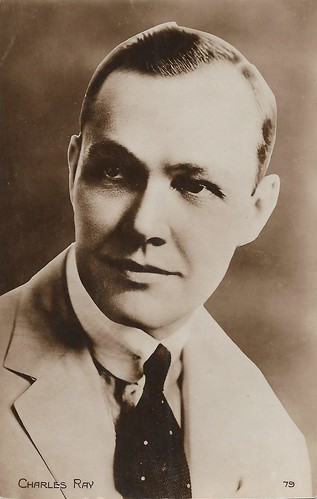
Charles Ray. French postcard by Editions Cinémagazine, no. 79. Photo: not indicated but could be made by Evans.
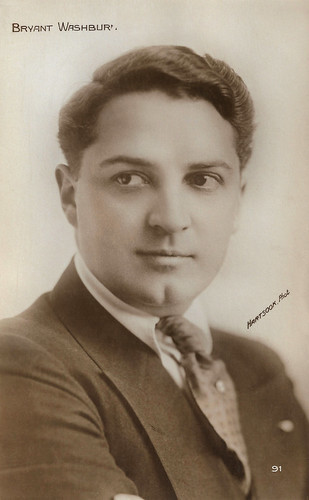
Bryant Washburne. French postcard by Editions Cinémagazine, no. 91. Photo: Hartsook.
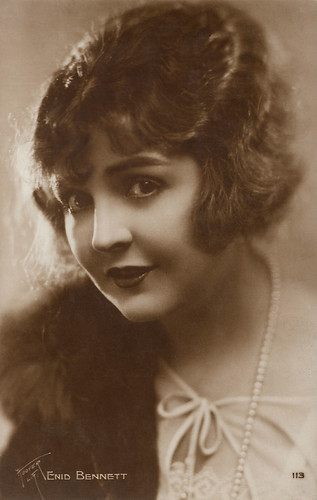
Enid Bennett. French postcard by Editions Cinémagazine, Paris, no. 113. Photo: Hoover.
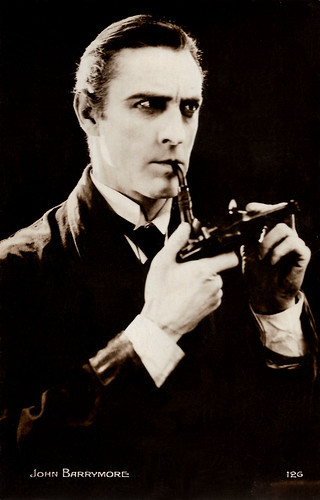
John Barrymore in Sherlock Holmes (Albert Parker, 1922). French postcard by Editions Cinémagazine, no. 126.
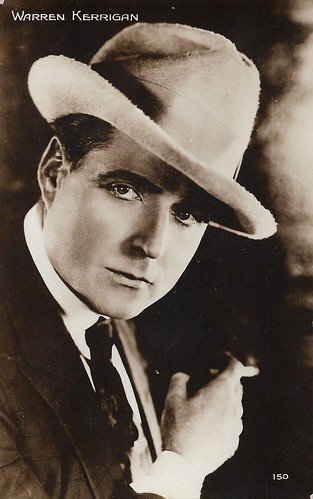
J. Warren Kerrigan. French postcard by Editions Cinémagazine, no. 150.

Barbara La Marr. French postcard by Editions Cinémagazine, Paris, no. 159. Photo: Hoover.
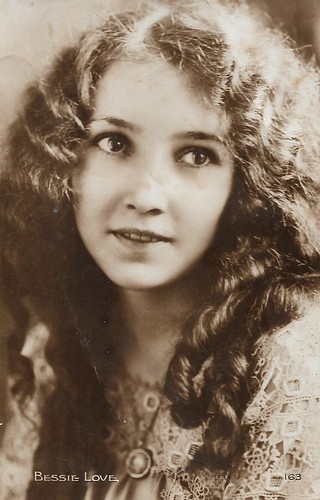
Bessie Love. French postcard by Editions Cinémagazine, Paris, no. 163.
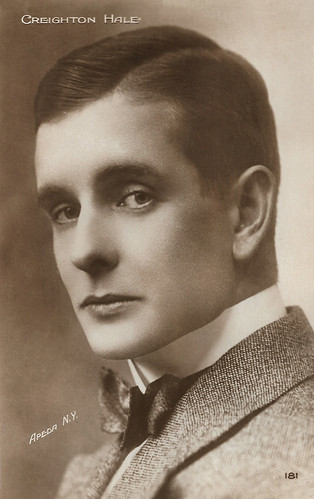
Creighton Hale. French postcard by Editions Cinémagazine, Paris, no. 181. Photo Apeda, New York.
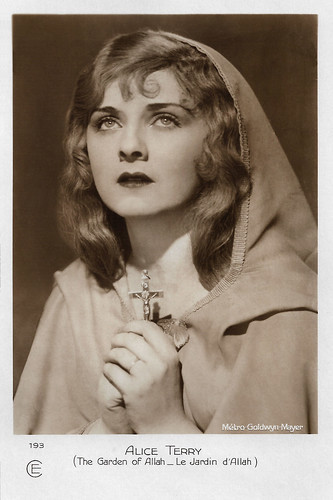
Alice Terry in The Garden of Allah (Rex Ingram, 1927). French postcard by Editions Cinémagazine, no. 193. Photo: Metro-Goldwyn-Mayer.
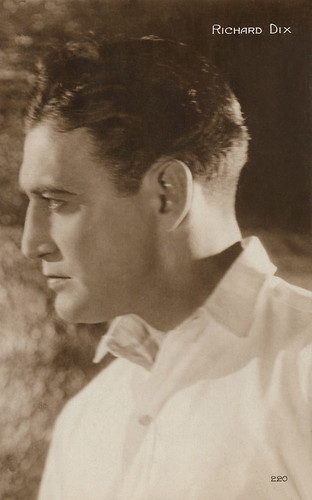
Richard Dix. French postcard by Editions Cinémagazine, no. 220.
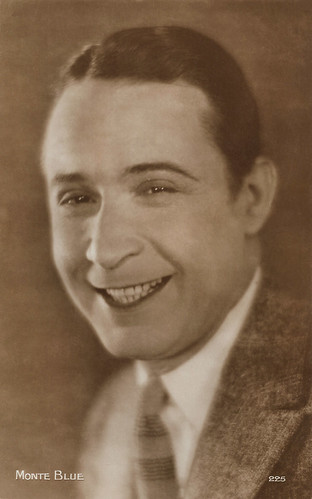
Monte Blue. French postcard by Editions Cinémagazine, no. 226.
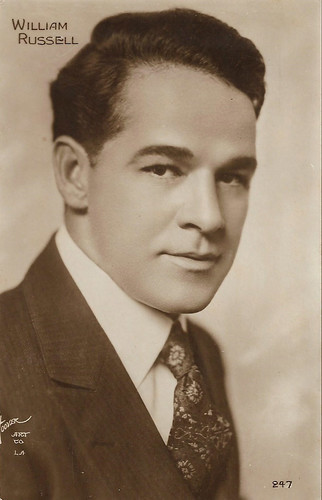
William Russell. French postcard by Editions Cinémagazine, no. 247. Photo: Hoover Art Co, Los Angeles.
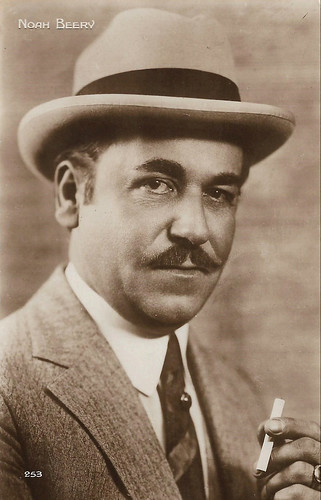
Noah Beery. French postcard by Editions Cinémagazine, no. 253.
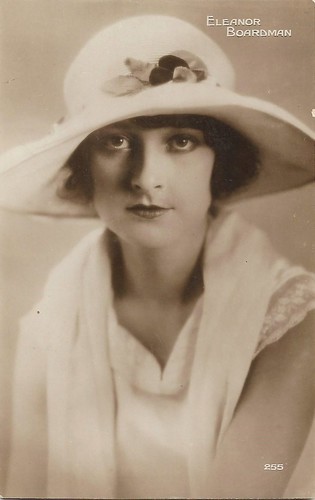
Eleanor Boardman. French postcard by Editions Cinémagazine, no. 255.
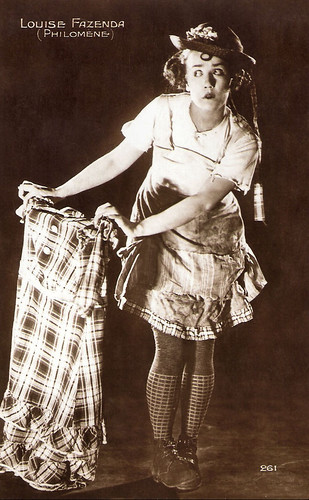
Louise Fazenda in The Kitchen Lady (Edward F. Cline, 1918). French postcard by Editions Cinémagazine, no. 261.
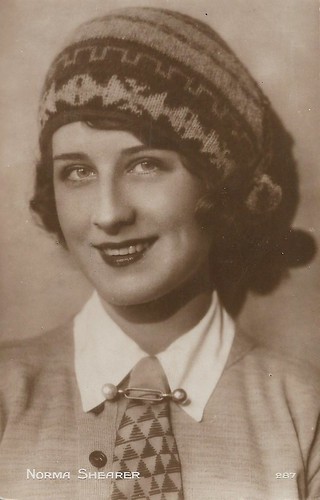
Norma Shearer. French postcard by Editions Cinémagazine, no. 287.
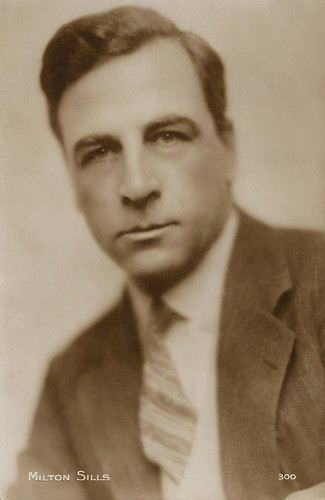
Milton Sills. French postcard by Editions Cinémagazine, no. 300.
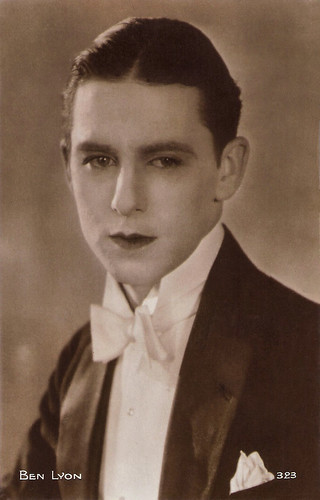
Ben Lyon. French postcard by Editions Cinémagazine, no. 323.
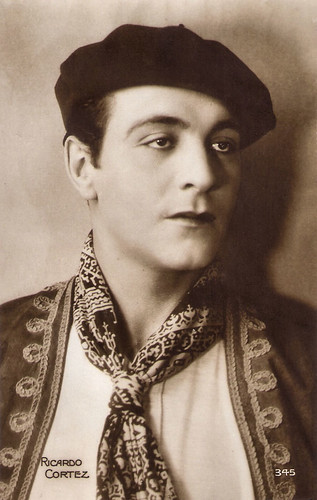
Ricardo Cortez. French postcard by Editions Cinémagazine, no. 345.
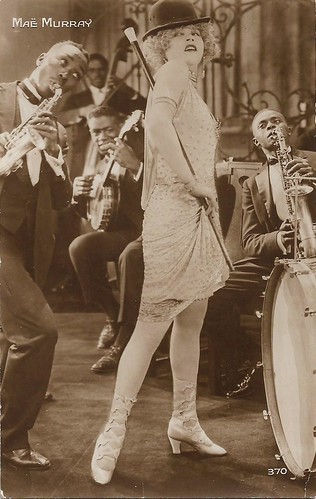
Mae Murray . French postcard by Editions Cinémagazine, no. 370.
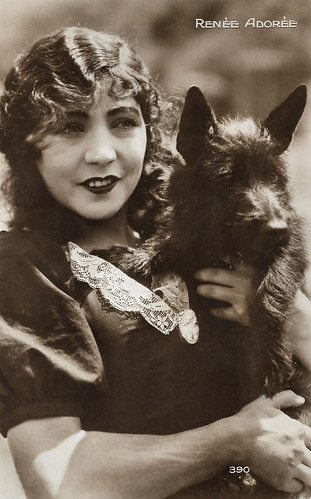
Renée Adorée. French postcard by Editions Cinémagazine, no. 390.
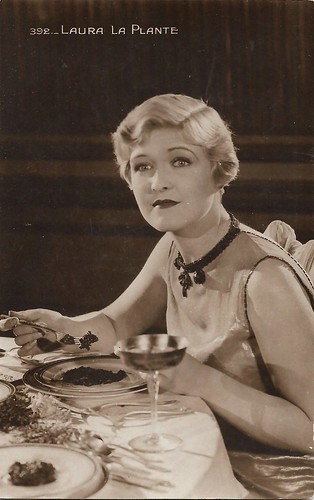
Laura La Plante. French postcard by Editions Cinémagazine, no. 392.
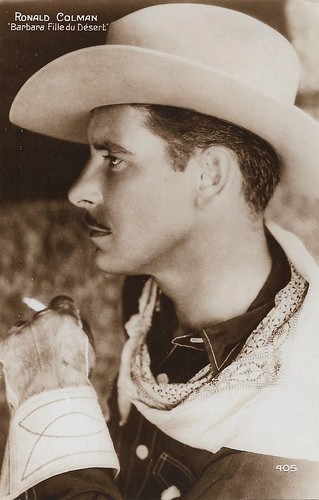
Ronald Colman in The Winning of Barbara Worth (Henry King, 1926). French postcard by Editions Cinémagazine, no. 405.
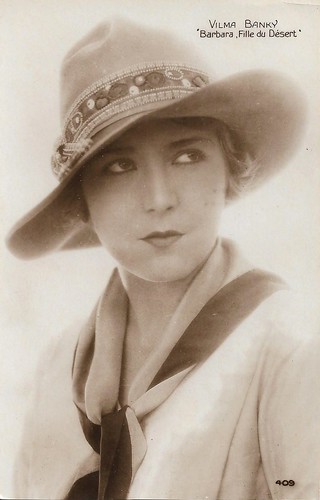
Vilma Banky in The Winning of Barbara Worth (Henry King, 1926). French postcard by Editions Cinémagazine, no. 409.
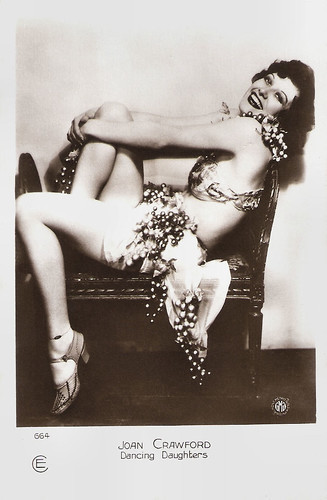
Joan Crawford in Our Dancing Daughters (Harry Beaumont, 1928). French postcard by Cinémagazine-Edition, no. 664. Photo: MGM.
At Mark Goffee's site on the Ross Verlag postcards, you can also find a list of the Cinémagazine postcards. Check it out.

Charles Ray. French postcard by Editions Cinémagazine, no. 79. Photo: not indicated but could be made by Evans.

Bryant Washburne. French postcard by Editions Cinémagazine, no. 91. Photo: Hartsook.

Enid Bennett. French postcard by Editions Cinémagazine, Paris, no. 113. Photo: Hoover.

John Barrymore in Sherlock Holmes (Albert Parker, 1922). French postcard by Editions Cinémagazine, no. 126.

J. Warren Kerrigan. French postcard by Editions Cinémagazine, no. 150.

Barbara La Marr. French postcard by Editions Cinémagazine, Paris, no. 159. Photo: Hoover.

Bessie Love. French postcard by Editions Cinémagazine, Paris, no. 163.

Creighton Hale. French postcard by Editions Cinémagazine, Paris, no. 181. Photo Apeda, New York.

Alice Terry in The Garden of Allah (Rex Ingram, 1927). French postcard by Editions Cinémagazine, no. 193. Photo: Metro-Goldwyn-Mayer.

Richard Dix. French postcard by Editions Cinémagazine, no. 220.

Monte Blue. French postcard by Editions Cinémagazine, no. 226.

William Russell. French postcard by Editions Cinémagazine, no. 247. Photo: Hoover Art Co, Los Angeles.

Noah Beery. French postcard by Editions Cinémagazine, no. 253.

Eleanor Boardman. French postcard by Editions Cinémagazine, no. 255.

Louise Fazenda in The Kitchen Lady (Edward F. Cline, 1918). French postcard by Editions Cinémagazine, no. 261.

Norma Shearer. French postcard by Editions Cinémagazine, no. 287.

Milton Sills. French postcard by Editions Cinémagazine, no. 300.

Ben Lyon. French postcard by Editions Cinémagazine, no. 323.

Ricardo Cortez. French postcard by Editions Cinémagazine, no. 345.

Mae Murray . French postcard by Editions Cinémagazine, no. 370.

Renée Adorée. French postcard by Editions Cinémagazine, no. 390.

Laura La Plante. French postcard by Editions Cinémagazine, no. 392.

Ronald Colman in The Winning of Barbara Worth (Henry King, 1926). French postcard by Editions Cinémagazine, no. 405.

Vilma Banky in The Winning of Barbara Worth (Henry King, 1926). French postcard by Editions Cinémagazine, no. 409.

Joan Crawford in Our Dancing Daughters (Harry Beaumont, 1928). French postcard by Cinémagazine-Edition, no. 664. Photo: MGM.
At Mark Goffee's site on the Ross Verlag postcards, you can also find a list of the Cinémagazine postcards. Check it out.
Published on September 13, 2019 22:00
September 12, 2019
Massimo Girotti
Handsome, manly Italian actor Massimo Girotti (1918-2003) had a career that spanned seven decades. He is best remembered for three roles: the young wanderer Gino in Luchino Visconti's Ossessione (1943), the stern lover in Michelangelo Antonioni's Cronaca di un amore (1950) and the passionate patriot in Visconti's Senso (1954).
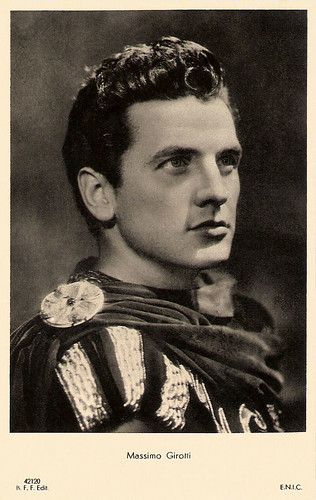
Italian postcard by B.F.F. Edit., no. 42920. Photo: E.N.I.C. Massimo Girotti in La corona di ferro/The Iron Crown (Alessandro Blasetti, 1941).
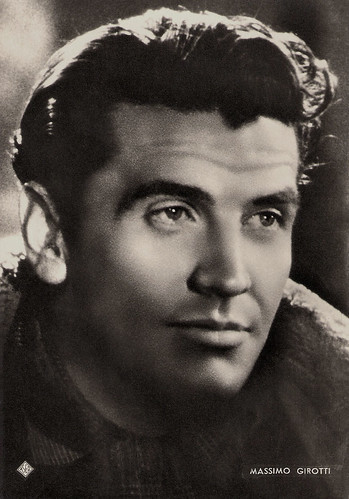
Italian postcard by ASER (A. Scaramaglia Ed. Roma), no. 223. Photo: Ciolfi.
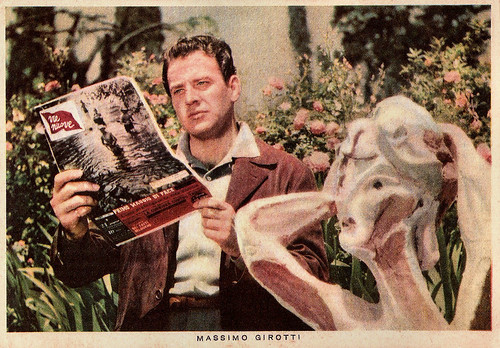
Italian postcard by Gros Monti & C., Torino for Vie Nuove, Settimanale illustrato a colori.
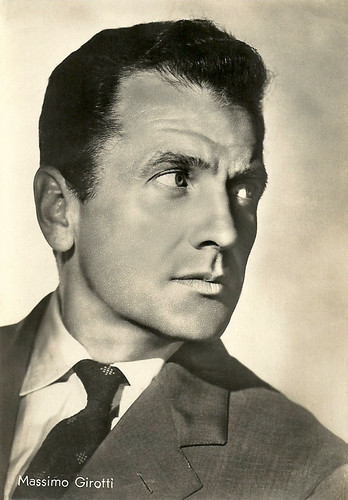
Italian postcard by Bromostampa, Milano. Foto: Dial.
Luchino Visconti
Massimo Girotti was born in Mogliano, Italy in 1918.
He was an engineering student, who thanks to his athletic physique - he was a champion swimmer and polo player - was noted by writer Mario Soldati. Soldati offered him a small part in his first feature as a director, Dora Nelson (Mario Soldati, 1940) featuring Assia Noris .
He also played a small part in Tosca/The Story of Tosca (Jean Renoir, Carl Koch, 1941) with Imperio Argentina , for which Luchino Visconti was an assistant-director.
Girotti had a bigger part in Alessandro Blasetti's mythological extravaganza La corona di ferro/The Iron Crown (1941). He took the double role of the fairytale King, killed in the prologue, and his Tarzan-like son Arminio, who has been nurtured by lions in the forest. Blasetti's film made him a popular star.
Roberto Rossellini cast him in his next film, the war drama Un pilota ritorna/A Pilot Returns (Roberto Rossellini, 1941), written by Benito Mussolini's son Vittorio Mussolini, who was then head of the Italian film industry. In this film Girotti plays a pilot shot down over Greece and captured by the British. After a love affair with the daughter of an Italian doctor, he manages to escape and return.
In 1943 came a turning point in his career when Luchino Visconti cast him opposite the torrid Clara Calamai in Ossessione/Obsession (Luchino Visconti, 1943), the unauthorised Italian version of James M. Cain's steamy novel The Postman Always Rings Twice.
In Ossessione the camera's eye on Girotti's Gino shows Visconti's predilection for the actor. In his published memoirs Girotti confessed he felt embarassed about Visconti's amorous attention for him, not very clear to viewers then but quite clear to us now. Although Girotti was happily married for most of his life, his relationship with Visconti was reportedly not completely platonic. Girotti would go on to cooperate several more times with Visconti, both on stage and in films. The combined sexiness of Girotti and Calamai in Ossesione was provocative for the times - as was the daring earthiness of the story.
The film marked the birth of what was later known as Neo-realism. Robert Firsching writes at AllMovie : "the movie began to feature some of neorealism's defining characteristics: above all, an emphasis on outdoor shooting and natural light and a relentless focus on the lives of the poor. Ossessione caused a sensation not just because of its lurid subject matter but also because Visconti's realist style makes you practically feel the heat and dirt and sweat of the film's environment." When the fascists saw the film, it was hurriedly withdrawn.
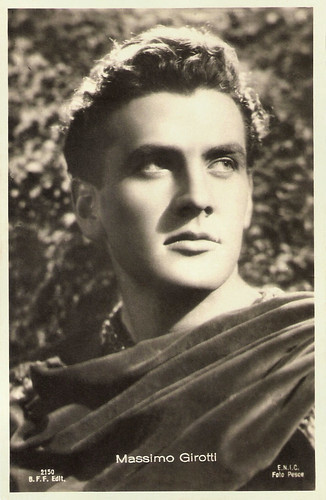
Italian postcard by Balleri & Fratini, Firenze, Editori (B.F.F. Edit.), no. 2150. Photo Pesce / ENIC. Massimo Girotti in La corona di ferro/The Iron Crown (Alessandro Blasetti, 1941).
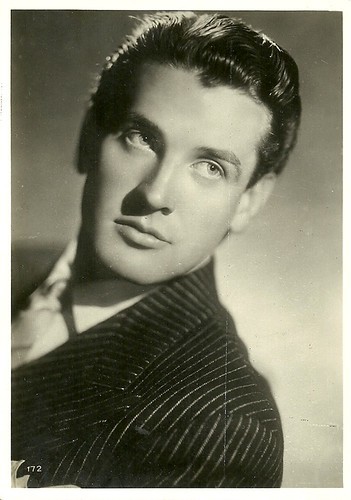
Italian postcard, no. 172. Photo: Ghergo.
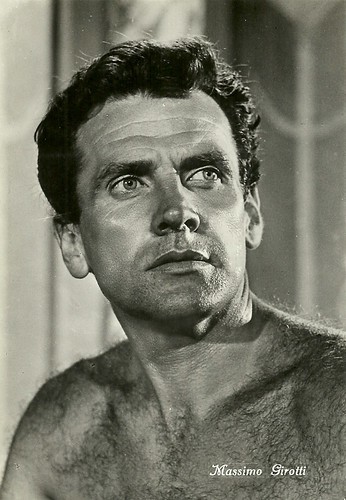
Italian postcard by Vetta Traldi, Milano, no. 100. Postcard probably for the epic Fabiola (Alessandro Blasetti, 1949), in which Girotti played (Saint) Sebastian, the Head of the Pretorian Guard, who dies as a Christian martyr. Could also be for Spartaco (Riccardo Freda, 1953).
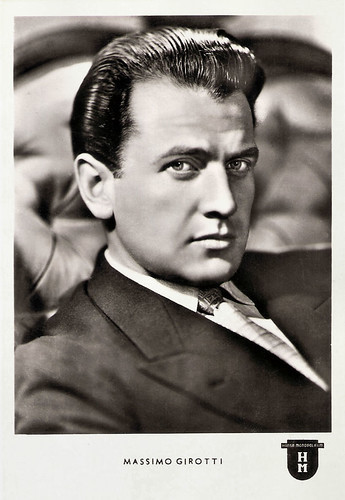
German postcard by Kunst und Bild, Berlin, no. A 182. Photo: Hansa Monopol Film.
Michelangelo Antonioni's Debut
During the German occupation, Massimo Girotti played in La porta del cielo/The Gate of Heaven (Vittorio De Sica, 1944) with Marina Berti , a film funded with Catholic money and also set in a Catholic environment. The film was released after the liberation, in the autumn of 1944.
After the war, Girotti played in various neorealist films such as Desiderio (Marcello Pagliero, Roberto Rossellini, 1946), Caccia tragica/The Tragic Hunt (Giuseppe De Santis, 1947) with Vivi Gioi , and the early mafia western In nome della legge/In the Name of the Law (Pietro Germi, 1949) with Charles Vanel .
He also starred opposite Lucia Bosé in the modernist drama Cronaca di un amore/Story of a Love Affair (Michelangelo Antonioni, 1950). Antonioni's feature film debut is the story of two lovers who plot to kill her husband, set among the Milanese rich.
Michael Hastings reviews the film at AllMovie : "Michelangelo Antonioni's first narrative feature is a stark, minimal interpersonal drama that would establish many of the themes and techniques that would recur in his work for the rest of his career. (...) Filled with stark, empty compositions, unpredictable camera movements, and static, self-obsessed characters, Story of a Love Affair would mark Antonioni as a maverick among the prevailing neorealists of the post-war Italian film community."
From the early 1950s on, Girotti also played in various epic films, such as Fabiola (Alessandro Blasetti, 1949) with Michèle Morgan , as slave-turned-leader Spartacus in Spartaco/Sins of Rome (Riccardo Freda, 1953), and Romolo e Remo/Duel of the Titans (Sergio Corbucci, 1961) featuring Steve Reeves .
In 1954 he returned to Visconti to play in Senso/Livia (Luchino Visconti, 1954), giving perhaps the finest performance of his career as the noble and passionate patriot Ussoni who is defeated by the Austrians.
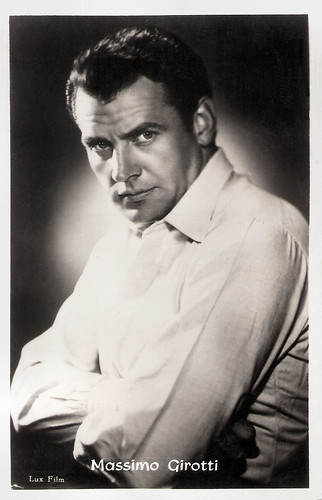
Italian card. Photo: Lux Film.
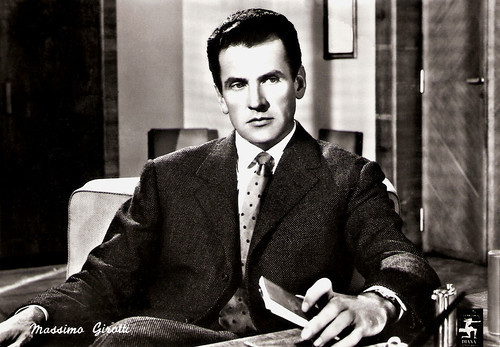
Italian postcard by Bromofoto, Milano, no. 1059. Photo: Diana. Girotti played in the Diana production Disperato addio/Desperate goodbye (Lionello Di Felice, 1955), in which he wears the same tie.
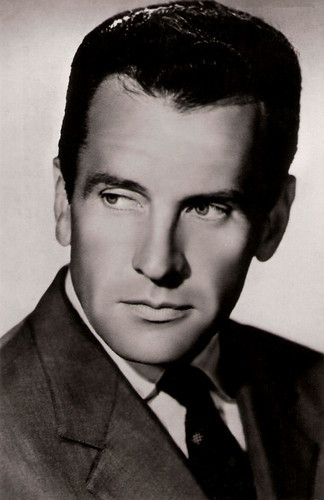
Russian postcard by Izogiz, Moscow, no. 3, 1958. Retail price: 75 K. The postcard was issued in an edition of 20.000.
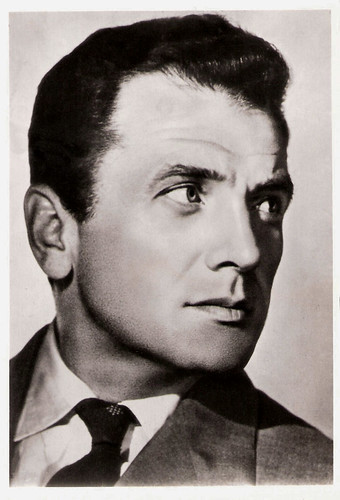
Russian postcard, no. M 19439, 1958. Retail price: 70 K. The postcard was issued in an edition of 100.000.
Pier Paolo Pasolini
In his later career Massimo Girotti appeared in a large number of mainly Italian films for directors such as Carlo Lizzani, Mauro Bolognini, Vittorio Cottafavi, and Alberto Lattuada.
As Gary Brumburgh writes at IMDb : "in the 60s, however, Girotti was reduced to support roles in swashbuckling adventure and badly-dubbed sand-and-spear spectacles".
His most memorable roles in this decade were the bourgeois industrialist in Pier Paolo Pasolini's Teorema/Theorem (1968), who, like the rest of his family, is seduced by Terence Stamp , and at the end strips in a train station and walks into the desert, and King Kresus/Creonte opposite Maria Callas in Medea (Pier Paolo Pasolini, 1970).
He played the pivotal role of the lover of Marlon Brando 's dead wife Ultimo tango a Parigi/Last Tango in Paris (Bernardo Bertolucci, 1972). Girotti also appeared in Le streghe/The Witches (Luchino Visconti, 1967), Monsieur Klein/Mr. Klein (Joseph Losey, 1976), L'Innocente/The Innocent (Luchino Visconti, 1976), Passione d'amore (Ettore Scola, 1981), and as the respectable neighbour of a suspected serial killer in the hilarious Il mostro/The Monster (Roberto Benigni, 1994).
Massimo Girotti's last role was a mysterious old wanderer - an old Gino? - in La finestra di fronte/Facing Windows (Ferzan Ozpetek, 2003). He proves to be a Jewish homosexual baker who is tormented his whole life by sacrificing his lover to save the Jews from the Roman ghetto.
Massimo Girotti died of a heart attack in Rome, in 2003, just after finishing the film. He was 84.
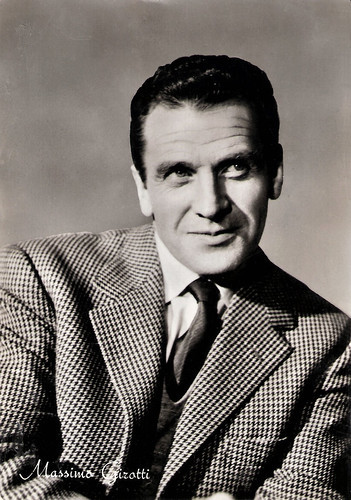
Italian postcard by Rotalfoto.
Trailer for Ossessione (1943). Source: Auto-B-Good Episode (YouTube).
Trailer for Senso (1955). Source: Rialto Films (YouTube).
Trailer for La Finestra Di Fronte/Facing Windows (2003). Source: CG Entertainment (YouTube).
Sources: John Francis Lane (The Guardian), Hal Erickson (AllMovie), (IMDb), Wikipedia and .

Italian postcard by B.F.F. Edit., no. 42920. Photo: E.N.I.C. Massimo Girotti in La corona di ferro/The Iron Crown (Alessandro Blasetti, 1941).

Italian postcard by ASER (A. Scaramaglia Ed. Roma), no. 223. Photo: Ciolfi.

Italian postcard by Gros Monti & C., Torino for Vie Nuove, Settimanale illustrato a colori.

Italian postcard by Bromostampa, Milano. Foto: Dial.
Luchino Visconti
Massimo Girotti was born in Mogliano, Italy in 1918.
He was an engineering student, who thanks to his athletic physique - he was a champion swimmer and polo player - was noted by writer Mario Soldati. Soldati offered him a small part in his first feature as a director, Dora Nelson (Mario Soldati, 1940) featuring Assia Noris .
He also played a small part in Tosca/The Story of Tosca (Jean Renoir, Carl Koch, 1941) with Imperio Argentina , for which Luchino Visconti was an assistant-director.
Girotti had a bigger part in Alessandro Blasetti's mythological extravaganza La corona di ferro/The Iron Crown (1941). He took the double role of the fairytale King, killed in the prologue, and his Tarzan-like son Arminio, who has been nurtured by lions in the forest. Blasetti's film made him a popular star.
Roberto Rossellini cast him in his next film, the war drama Un pilota ritorna/A Pilot Returns (Roberto Rossellini, 1941), written by Benito Mussolini's son Vittorio Mussolini, who was then head of the Italian film industry. In this film Girotti plays a pilot shot down over Greece and captured by the British. After a love affair with the daughter of an Italian doctor, he manages to escape and return.
In 1943 came a turning point in his career when Luchino Visconti cast him opposite the torrid Clara Calamai in Ossessione/Obsession (Luchino Visconti, 1943), the unauthorised Italian version of James M. Cain's steamy novel The Postman Always Rings Twice.
In Ossessione the camera's eye on Girotti's Gino shows Visconti's predilection for the actor. In his published memoirs Girotti confessed he felt embarassed about Visconti's amorous attention for him, not very clear to viewers then but quite clear to us now. Although Girotti was happily married for most of his life, his relationship with Visconti was reportedly not completely platonic. Girotti would go on to cooperate several more times with Visconti, both on stage and in films. The combined sexiness of Girotti and Calamai in Ossesione was provocative for the times - as was the daring earthiness of the story.
The film marked the birth of what was later known as Neo-realism. Robert Firsching writes at AllMovie : "the movie began to feature some of neorealism's defining characteristics: above all, an emphasis on outdoor shooting and natural light and a relentless focus on the lives of the poor. Ossessione caused a sensation not just because of its lurid subject matter but also because Visconti's realist style makes you practically feel the heat and dirt and sweat of the film's environment." When the fascists saw the film, it was hurriedly withdrawn.

Italian postcard by Balleri & Fratini, Firenze, Editori (B.F.F. Edit.), no. 2150. Photo Pesce / ENIC. Massimo Girotti in La corona di ferro/The Iron Crown (Alessandro Blasetti, 1941).

Italian postcard, no. 172. Photo: Ghergo.

Italian postcard by Vetta Traldi, Milano, no. 100. Postcard probably for the epic Fabiola (Alessandro Blasetti, 1949), in which Girotti played (Saint) Sebastian, the Head of the Pretorian Guard, who dies as a Christian martyr. Could also be for Spartaco (Riccardo Freda, 1953).

German postcard by Kunst und Bild, Berlin, no. A 182. Photo: Hansa Monopol Film.
Michelangelo Antonioni's Debut
During the German occupation, Massimo Girotti played in La porta del cielo/The Gate of Heaven (Vittorio De Sica, 1944) with Marina Berti , a film funded with Catholic money and also set in a Catholic environment. The film was released after the liberation, in the autumn of 1944.
After the war, Girotti played in various neorealist films such as Desiderio (Marcello Pagliero, Roberto Rossellini, 1946), Caccia tragica/The Tragic Hunt (Giuseppe De Santis, 1947) with Vivi Gioi , and the early mafia western In nome della legge/In the Name of the Law (Pietro Germi, 1949) with Charles Vanel .
He also starred opposite Lucia Bosé in the modernist drama Cronaca di un amore/Story of a Love Affair (Michelangelo Antonioni, 1950). Antonioni's feature film debut is the story of two lovers who plot to kill her husband, set among the Milanese rich.
Michael Hastings reviews the film at AllMovie : "Michelangelo Antonioni's first narrative feature is a stark, minimal interpersonal drama that would establish many of the themes and techniques that would recur in his work for the rest of his career. (...) Filled with stark, empty compositions, unpredictable camera movements, and static, self-obsessed characters, Story of a Love Affair would mark Antonioni as a maverick among the prevailing neorealists of the post-war Italian film community."
From the early 1950s on, Girotti also played in various epic films, such as Fabiola (Alessandro Blasetti, 1949) with Michèle Morgan , as slave-turned-leader Spartacus in Spartaco/Sins of Rome (Riccardo Freda, 1953), and Romolo e Remo/Duel of the Titans (Sergio Corbucci, 1961) featuring Steve Reeves .
In 1954 he returned to Visconti to play in Senso/Livia (Luchino Visconti, 1954), giving perhaps the finest performance of his career as the noble and passionate patriot Ussoni who is defeated by the Austrians.

Italian card. Photo: Lux Film.

Italian postcard by Bromofoto, Milano, no. 1059. Photo: Diana. Girotti played in the Diana production Disperato addio/Desperate goodbye (Lionello Di Felice, 1955), in which he wears the same tie.

Russian postcard by Izogiz, Moscow, no. 3, 1958. Retail price: 75 K. The postcard was issued in an edition of 20.000.

Russian postcard, no. M 19439, 1958. Retail price: 70 K. The postcard was issued in an edition of 100.000.
Pier Paolo Pasolini
In his later career Massimo Girotti appeared in a large number of mainly Italian films for directors such as Carlo Lizzani, Mauro Bolognini, Vittorio Cottafavi, and Alberto Lattuada.
As Gary Brumburgh writes at IMDb : "in the 60s, however, Girotti was reduced to support roles in swashbuckling adventure and badly-dubbed sand-and-spear spectacles".
His most memorable roles in this decade were the bourgeois industrialist in Pier Paolo Pasolini's Teorema/Theorem (1968), who, like the rest of his family, is seduced by Terence Stamp , and at the end strips in a train station and walks into the desert, and King Kresus/Creonte opposite Maria Callas in Medea (Pier Paolo Pasolini, 1970).
He played the pivotal role of the lover of Marlon Brando 's dead wife Ultimo tango a Parigi/Last Tango in Paris (Bernardo Bertolucci, 1972). Girotti also appeared in Le streghe/The Witches (Luchino Visconti, 1967), Monsieur Klein/Mr. Klein (Joseph Losey, 1976), L'Innocente/The Innocent (Luchino Visconti, 1976), Passione d'amore (Ettore Scola, 1981), and as the respectable neighbour of a suspected serial killer in the hilarious Il mostro/The Monster (Roberto Benigni, 1994).
Massimo Girotti's last role was a mysterious old wanderer - an old Gino? - in La finestra di fronte/Facing Windows (Ferzan Ozpetek, 2003). He proves to be a Jewish homosexual baker who is tormented his whole life by sacrificing his lover to save the Jews from the Roman ghetto.
Massimo Girotti died of a heart attack in Rome, in 2003, just after finishing the film. He was 84.

Italian postcard by Rotalfoto.
Trailer for Ossessione (1943). Source: Auto-B-Good Episode (YouTube).
Trailer for Senso (1955). Source: Rialto Films (YouTube).
Trailer for La Finestra Di Fronte/Facing Windows (2003). Source: CG Entertainment (YouTube).
Sources: John Francis Lane (The Guardian), Hal Erickson (AllMovie), (IMDb), Wikipedia and .
Published on September 12, 2019 22:00
September 11, 2019
Dezső Kertész
Dezső Kertész (1890-1965) was a Hungarian stage and screen actor and theatre director. He acted in some 7 silent Hungarian films in the 1910s and returned to the set in the early sound era and the war years. After the war, he was sentenced to silence.
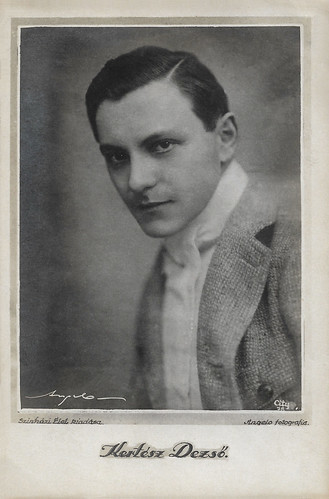
Hungarian postcard by Shinhasi Elat Kiadasa, no. 78. Photo: Angelo, Budapest / City.
A dashing count or a rich bachelor
Dezső Kertész or Desider Kertesz was born in 1890 in Békés, Hungary. He was the son of Gábor Kertész and Ida Kelemen. He graduated from his school in Arad, then was taught by Imre Pethes in Budapest.
He was first a member of Ignác Krecsányi's company. Between 1908 and 1909 he was an actor in Arad. Between 1909 and 1911 Kertész played in Győr. Between 1911 and 1912 he performed in Sopron.
Between 1912 and 1914 he was a member of the Buda-Timisoara company. In 1914 he also performed in Bratislava and Szombathely, and between 1915 and 1926 he was - with interruptions - a member of the Vígszínház (Comedy Theatre of Budapest) .
Dezső Kertész debuted on screen as the Baron's son Laszlo in the silent drama A Falu rossza/The Village Rogue (Miklós Pásztory, 1916), based on a play by Ede Tóth, and scripted by Ladislaus Vajda.
He then played opposite Ica Lenkeffy in the romantic film Szulamit (Jenö Illés, 1916), Dr. Gré in A Nevetö Szaszkia/The Laughing Saskia (Alexander Korda, 1916), and A szentjóbi erdö titka/The Secret of St. Job Forest (Michael Curtiz, 1917). In Három hét (Márton Garas, 1917), based on Elinor Glyn's 'Three Weeks', his co-star was Sári Fedák . She played an unhappily married Queen who steps out for three weeks with a dashing count (Kertész).
Similarly, Kertész played the rich bachelor Vronsky in Anna Karenina (Márton Garas, 1918), an adaptation of Leo Tolstoy's novel with Irén Varsányi in the title role.
In 1919 he acted in A Táncosnö/The Dancer (Márton Garas, 1919) opposite Leopoldine Konstantin and in the thriller A 111-es/Number 111 (Alexander Korda, 1919) starring Gábor Rajnay and María Corda . The film was based on a novel by Jenő Heltai. It was director Korda's final Hungarian film before he went into exile in Austria during the White Terror.
Kertész also had a supporting part in the Hungarian-Austrian silent horror film Drakula halála/Dracula's Death (Károly Lajthay, 1921), starring Paul Askonas. It marked the first screen appearance of the vampire Count Dracula (spelled 'Drakula'), although the film's plot did not at all follow the narrative of Bram Stoker's novel 'Dracula'.
After originally opening in Vienna in 1921 and enjoying a long and successful European run, Drakula halála was later re-edited and re-released in Budapest in 1923 as The Death of Dracula. The film was presumed to be a lost film but critic Troy Howarth states in his reference book 'Tome of Terror' that a print exists in a Hungarian archive.
All in all, Dezső Kertész acted in some 18 silent Hungarian films until 1921.
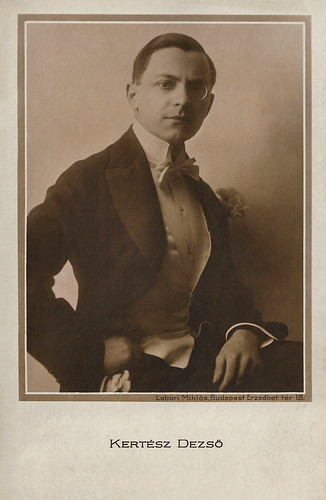
Hungarian postcard by József Reinitz, Budapest. Photo: Miklós Labori, Budapest.
Six years sentenced to silenceDezső Kertész also directed silent films in Austria. The first was the fairy tale Rumpelstilzchen (Dezső Kertész, 1923), produced by Sascha-Film. It was followed by four more films in 1923-1924. Six years later he directed his last film, General Babka (Dezső Kertész, 1930), starring Wolf Albach-Retty , Angelo Ferrari and Mary Kid .
In 1929, Dezső Kertész married the actress Ilona Vaály in Terézváros, Hungary. From now on, he focused his career on the theatre. Between 1929 and 1932 he was a member of the King Theatre. Between 1933 and 1934 and between 1943 and 1944, he was working for the Budapest Operetta Theatre. Between 1934 and 1936 he was an actor at the Pest Hungarian Theatre. Between 1938 and 1940 he was the director of the Royal Theatre.
On screen, Deszö Kertész acted in the Hungarian version of J.M. Barrie's 'The Doctor's Secret', Az orvos titka (Tibor Tibor Hegedüs, 1930) at the Paris Paramount studios. He also had a major part in the comedy Vica, a vadevezös/Vica the wild boar (Béla Gaál, 1933).
Between 1940 and 1941 Kertész played on stage in Sopron and Pécs. Between 1941 and 1942 he was an actor at the Szeged National Theatre. Between 1942 and 1943 he was a member of the Merry Stage. In 1945 he played on the stage of the Downtown Theatre.
During the war years, he acted in three films, the comedy Estélyi ruha kötelezö/Evening dress compulsory (László Cserépy, Árpád Horváth, 1942), the drama Örségváltás/Changing the Guard (Viktor Bánky, 1942) starring Antal Páger, and Csalódás/Disappointment (Frigyes Bán, 1943).
From 1945 till 1951 Kertész was sentenced to silence. After the war, Kertesz had small parts in Hungarian films like the biopic Semmelweis (Frigyes Bán, 1952) and the short film Különös tárgyalás/Special negotiation (Dezsõ Varasdy, 1961).
Between 1953 and 1955 he was a member of Katona József Theatre in Kecskemét. From 1958 he was a member of the József Attila Theatre.
Dezső Kertész died in 1965 in Budapest. He was 73.
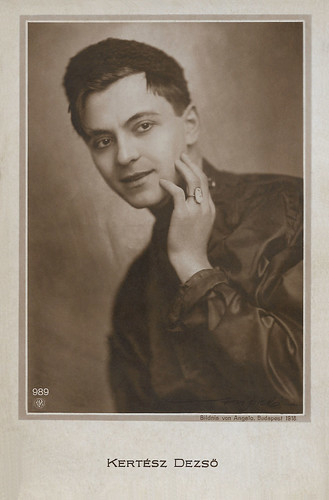
German postcard by NPG, no. 989. Photo: Angelo, Budapest, 1918.
Sources: Wikipedia (Hungarian and English) and .

Hungarian postcard by Shinhasi Elat Kiadasa, no. 78. Photo: Angelo, Budapest / City.
A dashing count or a rich bachelor
Dezső Kertész or Desider Kertesz was born in 1890 in Békés, Hungary. He was the son of Gábor Kertész and Ida Kelemen. He graduated from his school in Arad, then was taught by Imre Pethes in Budapest.
He was first a member of Ignác Krecsányi's company. Between 1908 and 1909 he was an actor in Arad. Between 1909 and 1911 Kertész played in Győr. Between 1911 and 1912 he performed in Sopron.
Between 1912 and 1914 he was a member of the Buda-Timisoara company. In 1914 he also performed in Bratislava and Szombathely, and between 1915 and 1926 he was - with interruptions - a member of the Vígszínház (Comedy Theatre of Budapest) .
Dezső Kertész debuted on screen as the Baron's son Laszlo in the silent drama A Falu rossza/The Village Rogue (Miklós Pásztory, 1916), based on a play by Ede Tóth, and scripted by Ladislaus Vajda.
He then played opposite Ica Lenkeffy in the romantic film Szulamit (Jenö Illés, 1916), Dr. Gré in A Nevetö Szaszkia/The Laughing Saskia (Alexander Korda, 1916), and A szentjóbi erdö titka/The Secret of St. Job Forest (Michael Curtiz, 1917). In Három hét (Márton Garas, 1917), based on Elinor Glyn's 'Three Weeks', his co-star was Sári Fedák . She played an unhappily married Queen who steps out for three weeks with a dashing count (Kertész).
Similarly, Kertész played the rich bachelor Vronsky in Anna Karenina (Márton Garas, 1918), an adaptation of Leo Tolstoy's novel with Irén Varsányi in the title role.
In 1919 he acted in A Táncosnö/The Dancer (Márton Garas, 1919) opposite Leopoldine Konstantin and in the thriller A 111-es/Number 111 (Alexander Korda, 1919) starring Gábor Rajnay and María Corda . The film was based on a novel by Jenő Heltai. It was director Korda's final Hungarian film before he went into exile in Austria during the White Terror.
Kertész also had a supporting part in the Hungarian-Austrian silent horror film Drakula halála/Dracula's Death (Károly Lajthay, 1921), starring Paul Askonas. It marked the first screen appearance of the vampire Count Dracula (spelled 'Drakula'), although the film's plot did not at all follow the narrative of Bram Stoker's novel 'Dracula'.
After originally opening in Vienna in 1921 and enjoying a long and successful European run, Drakula halála was later re-edited and re-released in Budapest in 1923 as The Death of Dracula. The film was presumed to be a lost film but critic Troy Howarth states in his reference book 'Tome of Terror' that a print exists in a Hungarian archive.
All in all, Dezső Kertész acted in some 18 silent Hungarian films until 1921.

Hungarian postcard by József Reinitz, Budapest. Photo: Miklós Labori, Budapest.
Six years sentenced to silenceDezső Kertész also directed silent films in Austria. The first was the fairy tale Rumpelstilzchen (Dezső Kertész, 1923), produced by Sascha-Film. It was followed by four more films in 1923-1924. Six years later he directed his last film, General Babka (Dezső Kertész, 1930), starring Wolf Albach-Retty , Angelo Ferrari and Mary Kid .
In 1929, Dezső Kertész married the actress Ilona Vaály in Terézváros, Hungary. From now on, he focused his career on the theatre. Between 1929 and 1932 he was a member of the King Theatre. Between 1933 and 1934 and between 1943 and 1944, he was working for the Budapest Operetta Theatre. Between 1934 and 1936 he was an actor at the Pest Hungarian Theatre. Between 1938 and 1940 he was the director of the Royal Theatre.
On screen, Deszö Kertész acted in the Hungarian version of J.M. Barrie's 'The Doctor's Secret', Az orvos titka (Tibor Tibor Hegedüs, 1930) at the Paris Paramount studios. He also had a major part in the comedy Vica, a vadevezös/Vica the wild boar (Béla Gaál, 1933).
Between 1940 and 1941 Kertész played on stage in Sopron and Pécs. Between 1941 and 1942 he was an actor at the Szeged National Theatre. Between 1942 and 1943 he was a member of the Merry Stage. In 1945 he played on the stage of the Downtown Theatre.
During the war years, he acted in three films, the comedy Estélyi ruha kötelezö/Evening dress compulsory (László Cserépy, Árpád Horváth, 1942), the drama Örségváltás/Changing the Guard (Viktor Bánky, 1942) starring Antal Páger, and Csalódás/Disappointment (Frigyes Bán, 1943).
From 1945 till 1951 Kertész was sentenced to silence. After the war, Kertesz had small parts in Hungarian films like the biopic Semmelweis (Frigyes Bán, 1952) and the short film Különös tárgyalás/Special negotiation (Dezsõ Varasdy, 1961).
Between 1953 and 1955 he was a member of Katona József Theatre in Kecskemét. From 1958 he was a member of the József Attila Theatre.
Dezső Kertész died in 1965 in Budapest. He was 73.

German postcard by NPG, no. 989. Photo: Angelo, Budapest, 1918.
Sources: Wikipedia (Hungarian and English) and .
Published on September 11, 2019 22:00
September 10, 2019
Armand Mestral
French actor and singer Armand Mestral (1917-2000) started his film career after the Second World War. At first he often played bad guys and later he played character roles both in the cinema and on television.
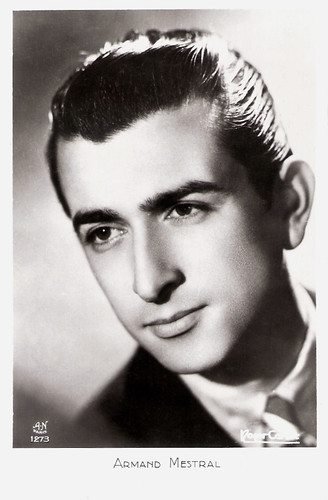
French postcard by A.N, Paris, no. 1273. Photo: Roger Carlet.
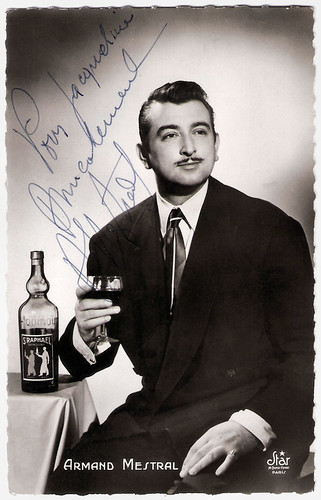
French postcard by Studio Star, Paris. Photo: Star, Paris.
Bad Guy
Armand Mestral was born in 1917 in Paris, France as Armand Serge Zelikson. His father was the Russian sculptor Chlioma Zelikson, and his mother was the designing artist Alice Eugénie Mestrallet.
Armand began his career began as a lyrical singer with a beautiful bass voice at the Saint-Roch church in Paris. He was engaged in the Gaîté-Lyrique theatre and appeared in operettas such as 'Le Pays du sourire' (The Land of Smiles) by Franz Lehár, 'Colorado' and 'Gypsy Song' by Maurice Yvain.
He recorded several chansons and his French versions of 'Jézabel' (Jezebel) and 'Mississippi' (Ol 'Man River) were among his greatest hits, which also included 'Chant des partisans' and 'L'Internationale'.
During the Second World War, he participated in the Resistance by sending messages through the collaborationist journal 'La France socialiste'.
After the war, he started to play in films, first often as a bad guy. His film debut was L'extravagante mission/The Queer Assignment (Henri Calef, 1945). Till 1992, he appeared as an actor and a singer in more than seventy French films from 1945 to 1992.
In 1953, he sang the French song 'Le Beau Pedro' in the comedy Soyez les bienvenus/Welcome (Pierre Louis, 1953). The song, which was written by Henri Betti (music) and Jean Nohain (lyrics), was also used that year in the hit film Le Portrait de son père/His Father's Portrait (André Berthomieu, 1953) with Jean Richard and Brigitte Bardot.
An well known film with Mestral was Gervaise (René Clément, 1956) starring Maria Schell and based on the novel 'L'Assommoir' by Émile Zola. Schell plays a working-class woman in the mid-nineteenth century trying to cope with the descent of her husband ( François Périer ) into alcoholism. Mestral played Lantier, Gervaise's former lover. The film was nominated for the Best Foreign Language Film at the 29th Academy Awards. Schell won the Volpi Cup for Best Actress at the 1956 Venice Film Festival.
He played a chauffeur in the crime film Enigme aux Folies-Bergère/The Enigma of the Folies-Bergere (Jean Mitry, 1959) about a series of murders at the Folies-Bergère. Mestral co-starred with Bella Darvi , Frank Villard and Dora Doll.
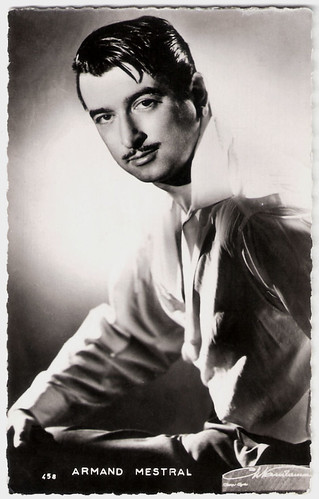
French postcard by Editions P.I., Paris, offered by Les Carbones Korès, no. 27 E / 458. Photo: Ch. Vandamme.
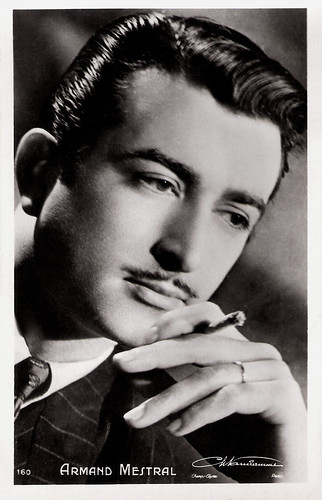
French postcard by Editions P.I., Paris, offered by Les Carbones "Arrow" "Carbofrance'', no. 160. Photo: Ch. Vandamme, Paris.
International co-productions
During the 1960s, Armand Mestral apeared in several international co-productions, like the Peplum Morgan il pirata/Morgan, the Pirate (André de Toth, Primo Zeglio, 1960). Steve Reeves starred as Sir Henry Morgan, the 17th Century pirate who became the self-proclaimed governor of Jamaica.
In Italy, he also appeared in the French-Italian coproduction L'ammutinamento/White Slave Ship (Silvio Amadio, 1961), starring Pier Angeli and Edmund Purdom , and in the adventure film Duello nella Sila/Duel of Fire (Umberto Lenzi, 1962), starring Fernando Lamas and Liana Orfei.
Back in France he played a supporting part in the crime film Chair de poule/Goosebumps (Julien Duvivier, 1963) starring Robert Hossein , Catherine Rouvel and Jean Sorel . The screenplay is based on the novel 'Come Easy, Go Easy' by James Hadley Chase, which took several plot elements from 'The Postman Always Rings Twice' by James M. Cain.
In Germany, he appeared in the French-West German drama Begegnung in Salzburg/Encounter in Salzburg (Max Friedmann, 1964) starring Curd Jürgens , Nadia Gray and Viktor de Kowa . He also played i the French-Italian-Spanish adventure film Surcouf, le tigre des sept mers/The Sea Pirate (Sergio Bergonzelli, Roy Rowland, 1966), featuring Gérard Barray .
He also had a small role in the American war film Lost Command (Mark Robson, 19660 starring Anthony Quinn, Alain Delon , George Segal, Michèle Morgan , Maurice Ronet and Claudia Cardinale . The film, based on the best-selling 1960 novel 'The Centurions' by Jean Lartéguy, focuses on the story of French paratroopers battling in French Indochina and French Algeria.
On television, he frequently participates in such popular series as Les Cinq Dernières Minutes/The Last Five Minutes (1958-1960), Les Brigades du Tigre/The Tiger Brigades (1976) with Jean-Claude Bouillon, and Les Enquêtes du commissaire Maigret/The Investigations of Commissioner Maigret (1970, 1982) with Jean Richard. He also played in many TV films.
His later films included Mon oncle Benjamin/My Uncle Benjamin (Édouard Molinaro, 1969), starring Jacques Brel and Claude Jade , and Deux hommes dans la ville/Two Men in Town (José Giovanni, 1973) with Jean Gabin and Alain Delon .
Mestral was married twice to Jacqueline Martin. They married in 1941 and had two children, composer and conductor Patrice Mestral and actress Marie-Claude Mestral. They divorced in 1957, but remarried in 1973.
Armand Mestral passed away in 2000 in Paris, France. He was 82. His wife Jacqueline survived him. He was in the Montparnasse cemetery, in front of which he lived for many, many years.
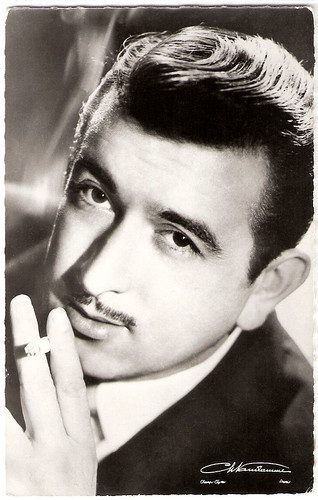
French postcard by Editions du Globe, Paris, no. 294. Photo: Ch. Vandamme, Paris.
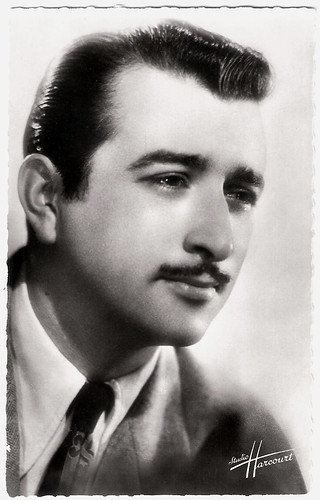
French postcard by Editions du Globe, Paris, no. 183. Photo: Studio Harcourt.
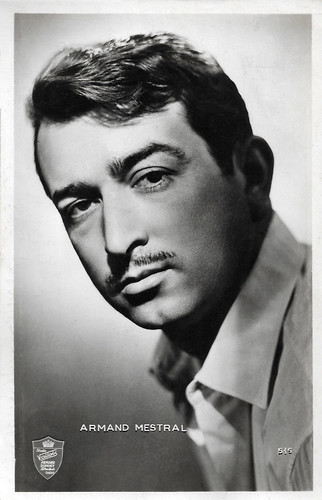
French postcard by Editions P.I., Paris, no. 13 G. Photo: Studio Vallois / Armand Duminy, Paris.
Sources: Wikipedia (French and English) and .

French postcard by A.N, Paris, no. 1273. Photo: Roger Carlet.

French postcard by Studio Star, Paris. Photo: Star, Paris.
Bad Guy
Armand Mestral was born in 1917 in Paris, France as Armand Serge Zelikson. His father was the Russian sculptor Chlioma Zelikson, and his mother was the designing artist Alice Eugénie Mestrallet.
Armand began his career began as a lyrical singer with a beautiful bass voice at the Saint-Roch church in Paris. He was engaged in the Gaîté-Lyrique theatre and appeared in operettas such as 'Le Pays du sourire' (The Land of Smiles) by Franz Lehár, 'Colorado' and 'Gypsy Song' by Maurice Yvain.
He recorded several chansons and his French versions of 'Jézabel' (Jezebel) and 'Mississippi' (Ol 'Man River) were among his greatest hits, which also included 'Chant des partisans' and 'L'Internationale'.
During the Second World War, he participated in the Resistance by sending messages through the collaborationist journal 'La France socialiste'.
After the war, he started to play in films, first often as a bad guy. His film debut was L'extravagante mission/The Queer Assignment (Henri Calef, 1945). Till 1992, he appeared as an actor and a singer in more than seventy French films from 1945 to 1992.
In 1953, he sang the French song 'Le Beau Pedro' in the comedy Soyez les bienvenus/Welcome (Pierre Louis, 1953). The song, which was written by Henri Betti (music) and Jean Nohain (lyrics), was also used that year in the hit film Le Portrait de son père/His Father's Portrait (André Berthomieu, 1953) with Jean Richard and Brigitte Bardot.
An well known film with Mestral was Gervaise (René Clément, 1956) starring Maria Schell and based on the novel 'L'Assommoir' by Émile Zola. Schell plays a working-class woman in the mid-nineteenth century trying to cope with the descent of her husband ( François Périer ) into alcoholism. Mestral played Lantier, Gervaise's former lover. The film was nominated for the Best Foreign Language Film at the 29th Academy Awards. Schell won the Volpi Cup for Best Actress at the 1956 Venice Film Festival.
He played a chauffeur in the crime film Enigme aux Folies-Bergère/The Enigma of the Folies-Bergere (Jean Mitry, 1959) about a series of murders at the Folies-Bergère. Mestral co-starred with Bella Darvi , Frank Villard and Dora Doll.

French postcard by Editions P.I., Paris, offered by Les Carbones Korès, no. 27 E / 458. Photo: Ch. Vandamme.

French postcard by Editions P.I., Paris, offered by Les Carbones "Arrow" "Carbofrance'', no. 160. Photo: Ch. Vandamme, Paris.
International co-productions
During the 1960s, Armand Mestral apeared in several international co-productions, like the Peplum Morgan il pirata/Morgan, the Pirate (André de Toth, Primo Zeglio, 1960). Steve Reeves starred as Sir Henry Morgan, the 17th Century pirate who became the self-proclaimed governor of Jamaica.
In Italy, he also appeared in the French-Italian coproduction L'ammutinamento/White Slave Ship (Silvio Amadio, 1961), starring Pier Angeli and Edmund Purdom , and in the adventure film Duello nella Sila/Duel of Fire (Umberto Lenzi, 1962), starring Fernando Lamas and Liana Orfei.
Back in France he played a supporting part in the crime film Chair de poule/Goosebumps (Julien Duvivier, 1963) starring Robert Hossein , Catherine Rouvel and Jean Sorel . The screenplay is based on the novel 'Come Easy, Go Easy' by James Hadley Chase, which took several plot elements from 'The Postman Always Rings Twice' by James M. Cain.
In Germany, he appeared in the French-West German drama Begegnung in Salzburg/Encounter in Salzburg (Max Friedmann, 1964) starring Curd Jürgens , Nadia Gray and Viktor de Kowa . He also played i the French-Italian-Spanish adventure film Surcouf, le tigre des sept mers/The Sea Pirate (Sergio Bergonzelli, Roy Rowland, 1966), featuring Gérard Barray .
He also had a small role in the American war film Lost Command (Mark Robson, 19660 starring Anthony Quinn, Alain Delon , George Segal, Michèle Morgan , Maurice Ronet and Claudia Cardinale . The film, based on the best-selling 1960 novel 'The Centurions' by Jean Lartéguy, focuses on the story of French paratroopers battling in French Indochina and French Algeria.
On television, he frequently participates in such popular series as Les Cinq Dernières Minutes/The Last Five Minutes (1958-1960), Les Brigades du Tigre/The Tiger Brigades (1976) with Jean-Claude Bouillon, and Les Enquêtes du commissaire Maigret/The Investigations of Commissioner Maigret (1970, 1982) with Jean Richard. He also played in many TV films.
His later films included Mon oncle Benjamin/My Uncle Benjamin (Édouard Molinaro, 1969), starring Jacques Brel and Claude Jade , and Deux hommes dans la ville/Two Men in Town (José Giovanni, 1973) with Jean Gabin and Alain Delon .
Mestral was married twice to Jacqueline Martin. They married in 1941 and had two children, composer and conductor Patrice Mestral and actress Marie-Claude Mestral. They divorced in 1957, but remarried in 1973.
Armand Mestral passed away in 2000 in Paris, France. He was 82. His wife Jacqueline survived him. He was in the Montparnasse cemetery, in front of which he lived for many, many years.

French postcard by Editions du Globe, Paris, no. 294. Photo: Ch. Vandamme, Paris.

French postcard by Editions du Globe, Paris, no. 183. Photo: Studio Harcourt.

French postcard by Editions P.I., Paris, no. 13 G. Photo: Studio Vallois / Armand Duminy, Paris.
Sources: Wikipedia (French and English) and .
Published on September 10, 2019 22:00
September 9, 2019
Thora van Deken (1920)
In the first half of the 20th century Pauline Brunius (1881-1954) was the grand old lady of the Swedish theatre. In the late 1910s and early 1920s, she also focused on film directing and film acting. In the silent psychological drama Thora van Deken/A Mother’s Fight (1920), she was directed by her husband, John W. Brunius. The film was based on 'Lille Rødhætte: Et Portræt' (Little Red Riding Hood: A Portrait) by Henrik Pontoppidan.
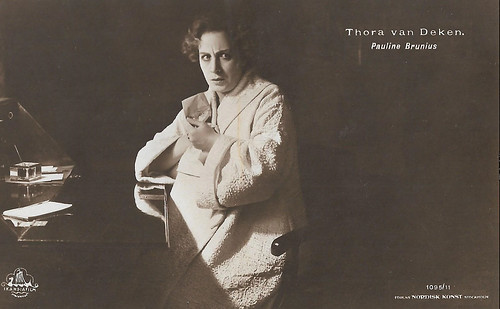
Swedish postcard by Verlag Nordisk Konst, Stockholm. no. 1095/11. Photo: Skandia Film. Pauline Brunius in Thora van Deken (John W. Brunius, 1920).
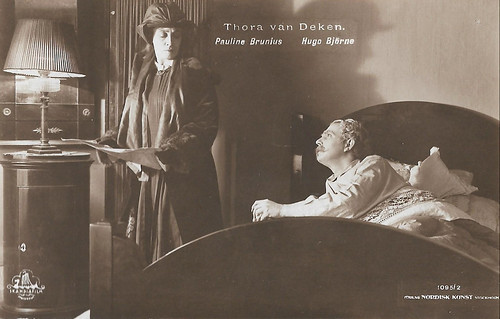
Swedish postcard by Verlag Nordisk Konst, Stockholm, no. 1095/2. Photo: Skandia Film. Pauline Brunius and Hugo Björne in Thora van Deken (John W. Brunius, 1920).
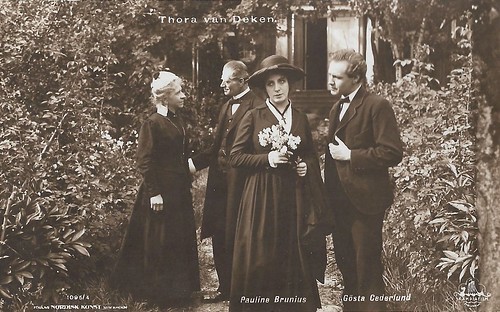
Swedish postcard by Verlag Nordisk Konst, Stockholm, no. 1095/4. Photo: Skandia Film. Pauline Brunius and Gösta Cederland in Thora van Deken (John W. Brunius, 1920).
A Testament and Rumours
Thora van Deken ( Pauline Brunius ), divorced wife of estate owner Niels Engelstoft (Hugo Björne), is called to her husband's deathbed by pastor Bjerring ( Gösta Ekman ), who tries to achieve a reconciliation between the spouses before the man dies.
Thora knows through the newspapers that Engelstoft in his will ordered the estate Sofiehöj to become a resting place for women and would be managed by rector Brandt (Oscar Johanson), brother of Sophie, the newly-deceased young woman with whom the landlord lived after his divorce.
Thora is determined to change this shameful relationship in favour of Esther (Jessie Wessel), her own daughter with Engelstoft. The meeting between the spouses becomes hesitant and suspicious. Thora reminds him of their common past, and the break-up of their marriage because of Engelstoft's infidelity with Sofie Brandt. Thora urges him to change his will for their daughter Esther's sake. The quarrel becomes awesome and ends with Engelstoft dying.
Thora then declares that the landowner, in her presence and out of free will, burned the testament and immediately before his death declared that his daughter Esther with Thora as guardian would take over Sofiehöj. This statement is faced with the distrust of the locals. The disputed Rector Brandt, along with his lawyer, takes steps to make the original testament valid.
Despite the rumours, Thora and Esther move into the manor house, where Pastor Bjerring becomes a frequent visitor, eventually becoming increasingly affectionate with Esther. Love is answered, which Thora sees with great concern because she does not want her daughter to give her life a great deal. She herself is full of self-denial.
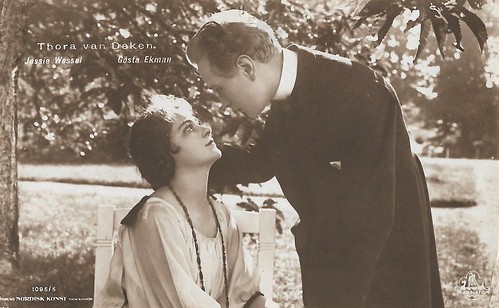
Swedish postcard by Verlag Nordisk Konst, Stockholm, no. 1095/5. Photo: Skandia Film. Gösta Ekman and Jessie Wessel in Thora van Deken (John W. Brunius, 1920).
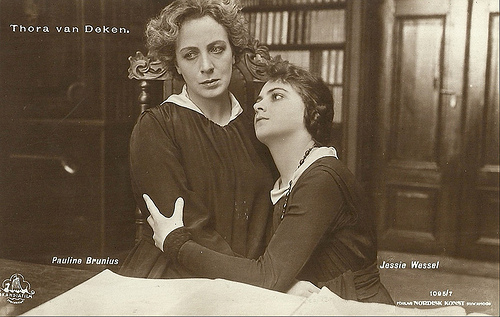
Swedish postcard by Verlag Nordisk Konst, Stockholm, no. 1095/7. Photo: Skandia Film. Pauline Brunius and Jessie Wessel in Thora van Deken (John W. Brunius, 1920).
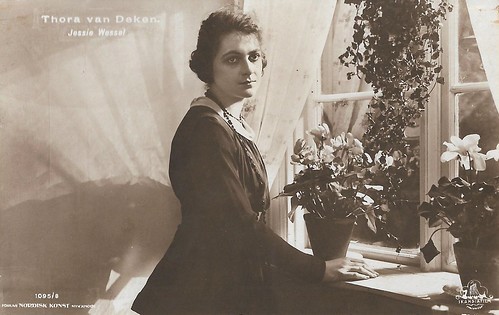
Swedish postcard by Verlag Nordisk Konst, Stockholm, no. 1095/8. Photo: Skandia Film. Jessie Wessel in Thora van Deken (John W. Brunius, 1920).
The breath of shame
When the courtesy's folly goes hand in hand, finally, Thora van Deken accepts district steward Lars Sidenius's (Gösta Cederlund) proposal to get the testament legally tested. Sidenius reminds Thora of that time long ago when he loved her but became so cruel when she married rich Niels Engelstoft. Sidenius has never ceased to love her and wishes nothing higher than to get her free from all unhappy suspicions.
An interrogation at the town hall follows, where Thora's duties are seriously asked, mainly by the nurse who cared for Engelstoft during his last day. Thora is forced to swear to her story: when she puts her fingers on the Bible, she sees the breath of shame. At the same time as the interrogation is in progress, two crucial events occur. Pastor Bjerring is asked to be accepted as an Asian missionary by a missionary company thanks to a donation from an anonymous donor (who is, in fact, Thora van Deken).
Esther discovers that her father's will has never been burned but is being stored in the secretary of Thora. This insight convinces Esther to follow the pastor and the couple embarks on a steamer that will bring them to Asia. Thora no longer has anything to live for. She surrenders the hidden testament of her husband, confesses and goes to prison.
In his review for Kosmorama, Casper Tybjerg writes: "The Swedish film Thora van Deken from 1920, though little-known and rarely seen, is a strikingly well-made and well-acted psychological drama. Based on a short novel by Henrik Pontoppidan, it is consistently structured around its title character, a hard and uncompromising woman who commits a crime for her daughter’s sake. (...) the film’s staging and the performance of the lead actress, Pauline Brunius , presents her to us in a gratifyingly non-judgmental and unsentimental way.
The film lacks the folkloristic ambience which many contemporaries regarded as a key quality of films like Victor Sjöström ’s The Sons of Ingmar . Nevertheless, Thora van Deken was explicitly presented and received as part of the same school or trend on the basis of its psychological realism and of the literary prestige of its source.
In 1920, Carl Th. Dreyer (then an up-and-coming young director) had written that the distinctive quality of the Swedish cinema of the post-Terje Vigen period – in contrast to both action-packed American movies and the crime thrillers and melodramas dominating the output of the Danish film industry – was its emphasis on psychology rather than physical action: “The Swedish art film […] has acquired its distinctive character by becoming a medium for true and genuine human representation”. On this view – which was echoed by a number of commentators at the time – Thora van Deken was very much a film that shared this distinctive character."
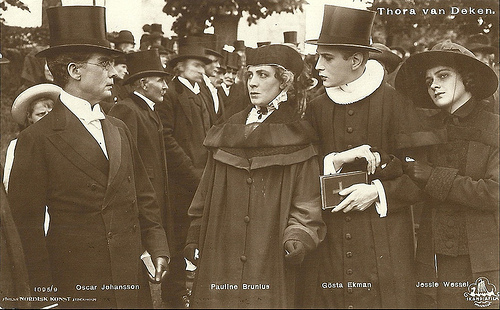
Swedish postcard by Verlag Nordisk Konst, Stockholm, no. 1095/9. Photo: Skandia Film. Pauline Brunius , Gösta Ekman , Jessie Wessel and Oscar Johansson in Thora van Deken (John W. Brunius, 1920).
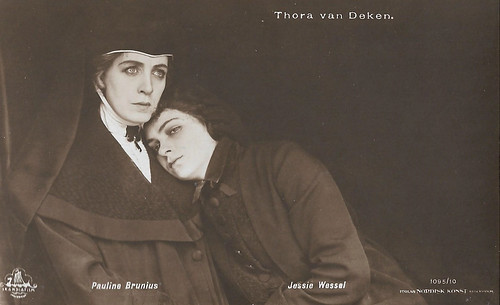
Swedish postcard by Verlag Nordisk Konst, Stockholm, no. 1095/10. Photo: Skandia Film. Pauline Brunius and Jessie Wessel in Thora van Deken (John W. Brunius, 1920).
Sources: Casper Tybjerg (Kosmorama), The Swedish Film Database, Wikipedia (Swedish) and IMDb .

Swedish postcard by Verlag Nordisk Konst, Stockholm. no. 1095/11. Photo: Skandia Film. Pauline Brunius in Thora van Deken (John W. Brunius, 1920).

Swedish postcard by Verlag Nordisk Konst, Stockholm, no. 1095/2. Photo: Skandia Film. Pauline Brunius and Hugo Björne in Thora van Deken (John W. Brunius, 1920).

Swedish postcard by Verlag Nordisk Konst, Stockholm, no. 1095/4. Photo: Skandia Film. Pauline Brunius and Gösta Cederland in Thora van Deken (John W. Brunius, 1920).
A Testament and Rumours
Thora van Deken ( Pauline Brunius ), divorced wife of estate owner Niels Engelstoft (Hugo Björne), is called to her husband's deathbed by pastor Bjerring ( Gösta Ekman ), who tries to achieve a reconciliation between the spouses before the man dies.
Thora knows through the newspapers that Engelstoft in his will ordered the estate Sofiehöj to become a resting place for women and would be managed by rector Brandt (Oscar Johanson), brother of Sophie, the newly-deceased young woman with whom the landlord lived after his divorce.
Thora is determined to change this shameful relationship in favour of Esther (Jessie Wessel), her own daughter with Engelstoft. The meeting between the spouses becomes hesitant and suspicious. Thora reminds him of their common past, and the break-up of their marriage because of Engelstoft's infidelity with Sofie Brandt. Thora urges him to change his will for their daughter Esther's sake. The quarrel becomes awesome and ends with Engelstoft dying.
Thora then declares that the landowner, in her presence and out of free will, burned the testament and immediately before his death declared that his daughter Esther with Thora as guardian would take over Sofiehöj. This statement is faced with the distrust of the locals. The disputed Rector Brandt, along with his lawyer, takes steps to make the original testament valid.
Despite the rumours, Thora and Esther move into the manor house, where Pastor Bjerring becomes a frequent visitor, eventually becoming increasingly affectionate with Esther. Love is answered, which Thora sees with great concern because she does not want her daughter to give her life a great deal. She herself is full of self-denial.

Swedish postcard by Verlag Nordisk Konst, Stockholm, no. 1095/5. Photo: Skandia Film. Gösta Ekman and Jessie Wessel in Thora van Deken (John W. Brunius, 1920).

Swedish postcard by Verlag Nordisk Konst, Stockholm, no. 1095/7. Photo: Skandia Film. Pauline Brunius and Jessie Wessel in Thora van Deken (John W. Brunius, 1920).

Swedish postcard by Verlag Nordisk Konst, Stockholm, no. 1095/8. Photo: Skandia Film. Jessie Wessel in Thora van Deken (John W. Brunius, 1920).
The breath of shame
When the courtesy's folly goes hand in hand, finally, Thora van Deken accepts district steward Lars Sidenius's (Gösta Cederlund) proposal to get the testament legally tested. Sidenius reminds Thora of that time long ago when he loved her but became so cruel when she married rich Niels Engelstoft. Sidenius has never ceased to love her and wishes nothing higher than to get her free from all unhappy suspicions.
An interrogation at the town hall follows, where Thora's duties are seriously asked, mainly by the nurse who cared for Engelstoft during his last day. Thora is forced to swear to her story: when she puts her fingers on the Bible, she sees the breath of shame. At the same time as the interrogation is in progress, two crucial events occur. Pastor Bjerring is asked to be accepted as an Asian missionary by a missionary company thanks to a donation from an anonymous donor (who is, in fact, Thora van Deken).
Esther discovers that her father's will has never been burned but is being stored in the secretary of Thora. This insight convinces Esther to follow the pastor and the couple embarks on a steamer that will bring them to Asia. Thora no longer has anything to live for. She surrenders the hidden testament of her husband, confesses and goes to prison.
In his review for Kosmorama, Casper Tybjerg writes: "The Swedish film Thora van Deken from 1920, though little-known and rarely seen, is a strikingly well-made and well-acted psychological drama. Based on a short novel by Henrik Pontoppidan, it is consistently structured around its title character, a hard and uncompromising woman who commits a crime for her daughter’s sake. (...) the film’s staging and the performance of the lead actress, Pauline Brunius , presents her to us in a gratifyingly non-judgmental and unsentimental way.
The film lacks the folkloristic ambience which many contemporaries regarded as a key quality of films like Victor Sjöström ’s The Sons of Ingmar . Nevertheless, Thora van Deken was explicitly presented and received as part of the same school or trend on the basis of its psychological realism and of the literary prestige of its source.
In 1920, Carl Th. Dreyer (then an up-and-coming young director) had written that the distinctive quality of the Swedish cinema of the post-Terje Vigen period – in contrast to both action-packed American movies and the crime thrillers and melodramas dominating the output of the Danish film industry – was its emphasis on psychology rather than physical action: “The Swedish art film […] has acquired its distinctive character by becoming a medium for true and genuine human representation”. On this view – which was echoed by a number of commentators at the time – Thora van Deken was very much a film that shared this distinctive character."

Swedish postcard by Verlag Nordisk Konst, Stockholm, no. 1095/9. Photo: Skandia Film. Pauline Brunius , Gösta Ekman , Jessie Wessel and Oscar Johansson in Thora van Deken (John W. Brunius, 1920).

Swedish postcard by Verlag Nordisk Konst, Stockholm, no. 1095/10. Photo: Skandia Film. Pauline Brunius and Jessie Wessel in Thora van Deken (John W. Brunius, 1920).
Sources: Casper Tybjerg (Kosmorama), The Swedish Film Database, Wikipedia (Swedish) and IMDb .
Published on September 09, 2019 22:00
September 8, 2019
Jadwiga Smosarska
Jadwiga Smosarska (1898-1971) was the biggest star of the Polish cinema of the pre-WWII era. From 1919 on, the Polish actress made more than 25 silent and sound films. She also was very successful on stage. When the Nazis invaded Poland in 1939, she fled to the US. In 1970, she returned to Poland.
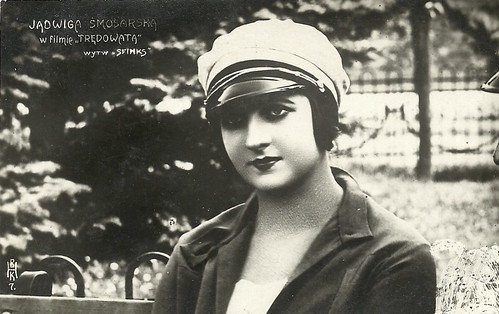
Polish postcard by BHK, no. 7. Photo: Sfinks. Jadwiga Smosarska in Tredowata/The Leper (Boleslaw Mierzejewski, Edward Puchalski, 1927). Collection: Didier Hanson.
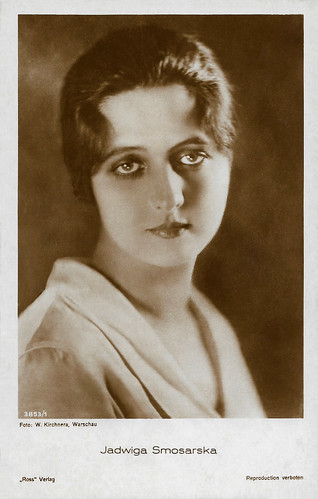
German postcard by Ross Verlag, no. 3853/1, 1928-1929. Photo: W. Kirchnera, Warschau (Warsaw).
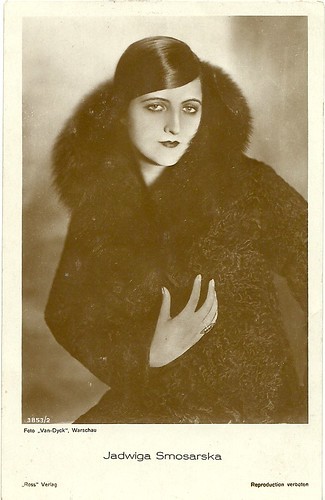
German postcard by Ross Verlag, no. 3853/2 1928-1929. Photo: Van-Dyck, Warschau (Warsaw). Collection: Didier Hanson.
Sarska
Jadwiga Filipina Smosarska was born in Warsaw as the daughter of Karol Smosarski, a chemist, and Waleria nee Darmos, a housewife and singer at charity concerts. She had three siblings, including two brothers.
Jadwiga spent her early childhood in the land estate of Jurka, where her father was the administrator. In 1905, the family moved to the capital. Five years later, father Karol died, and her mother had to earn a living for the children, working as a hairdresser.
As a teenage student, Jadwiga played in amateur performances. Her unofficial stage debut took place in 1916, in the role of the Virgin in Zygmunt Krasiński's 'Un-Divine Comedy', staged in the Polish Theatre by a student amateur group. After graduating in 1917, she studied acting with Władysław Staszkowski, and then enrolled for evening studies at the Warsaw Drama School, graduating with honours in 1920. In the meantime, she also earned her living by working at the Bank of Poland.
Under the pseudonym Sarska she made her debut in 1918 on the stage of the Summer Theatre in Warsaw in the farce 'Charley's Aunt'. In July 1920 she appeared in the diploma show of the Warsaw Drama School, and in September of the same year, she was involved in the Rozmaitosci Theatre team, where she worked until 1923. Her professional debut there was at the Summer Theater in the comedy 'Weteran' (Captain Swift), where she appeared together with Mieczysław Frenkel.
Until the Second World War, she would continue to perform at the stages of many Warsaw theaters, such as Rozmaitości (1920-1923), Polski and Mały (1924), Letni (1927), Narodowy, Nowy, Letni and Polski (1928-1939).
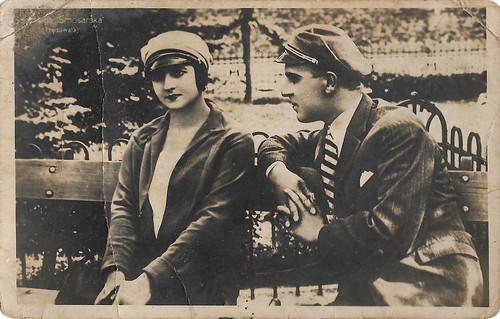
Polish postcard. Jadwiga Smosarska in Tredowata/The Leper (Edward Puchalski, Józef Węgrzyn 1926), adapted from the novel by Helena Mniszkówna. The man right of her is Léon Łuszcewski,
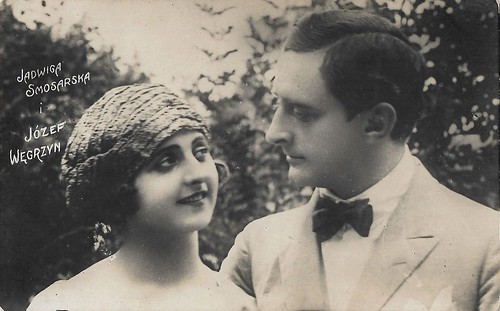
Polish postcard. Jadwiga Smosarska and Józef Wegrzyn.
The new star of the Sfinks
Jadwiga Smosarska's film debut was as Helena in Dla szczęścia/In the name of happiness (1919) by Aleksander Hertz, who then directed films at the company Sfinks.
After Pola Negri , the main star at Sfinks, had left for a career in Germany, Smosarska became the new star. English Wikipedia : "Smosarska was known for playing characters representative of Polish cliches that reflected the suffering of the country's citizens. Patriotic, romantic and in good social standing, her characters often struggled with malaise and a tragic love life."
Her famous titles included O czym sie nie mówi/The Unspeakable (Edward Puchalski, 1924), Tredowata/The Leper (Boleslaw Mierzejewski, Edward Puchalski, 1926) and the historical film Na Sybir/Exile to Siberia (Henryk Szaro, 1930). The latter was shot as a silent film, but a soundtrack was added in a Berlin studio.
Smosarska's passage to sound cinema went without obstacles, in contrast to others such as Irena Gawecka , whose film career ended because of the introduction of sound film. Smosarska starred in the historical film Barbara Radziwiłłówna (Józef Lejtes, 1936) which was the first feature film transmitted by Polish television during its test phase (on 26 August 1939).
Although she played in 26 Polish films, Smosarska more often appeared on the stages of Warsaw theatres, playing a total of 40 different plays. The cinema, however, brought her so much popularity that for many people (both audiences and critics) she was considered the biggest star of Polish pre-war cinema, winning in many popularity polls.
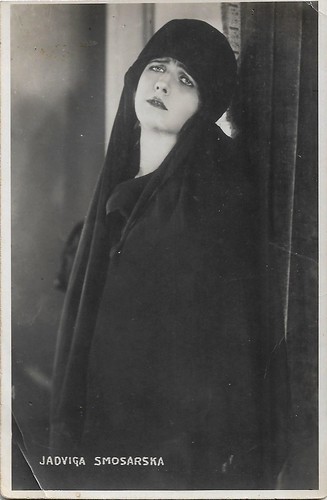
Polish postcard, no. Br 91811.
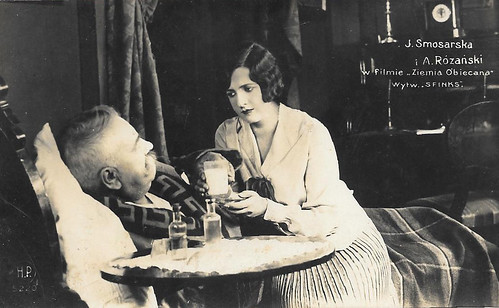
Polish postcard by H.P., no. 5220. Photo: Sfinks. Jadwiga Smosarska and Antoni Rozanski in Ziemia obiecana/The Promised Land (Zbigniew Gniazdowski, Aleksander Hertz, 1927). Collection: Didier Hanson.
A lucrative Hollywood contract
In 1932, Jadwiga Smosarska was discovered by Hollywood after her role in the period piece Księżna Łowicka (Mieczysław Krawicz, Janusz Warnecki, 1932), commemorating the Polish 1830-31 uprising.
However, the actress rejected a lucrative contract at one of the leading Hollywood majors because she did not want to leave Poland for a long time. In 1935, she married the engineer Zygmunt Protassewicz in the capital. The couple lived in a villa in Warsaw designed in accordance with Jadwiga's personal instructions. In 1938, she was awarded the Golden Cross of Merit: "in recognition of merits placed on the promotion of Polish film culture".
After the first bombings of Warsaw in September 1939, Smosarska and her husband fled to relatives in Lithuania. Subsequently, both of them arrived in Latvia, Sweden and Norway and in November 1939 in the USA, thanks to the proposal of Polish impresario Stanów Zjednoczonych, who had previously wanted to organise an American tour for her.
While the Hollywood industry would not accept her because of her accent, she appeared in the role of Julia in Aleksander Fredo's comedy 'Pierwszy Lepsza' (First Better), in the Polish Theatre of Artists in New York in the spring of 1944.
Around 1950, the couple lived in their own house with a garden in Middlebury, where Protassewicz ran a large precision tool factory. Polish emigrants and newcomers from Poland often visited them.
In 1954 Smosarska toured Canada to raise money for assisting Polish immigrants. After the war, she visited Poland several times and finally returned with her husband to her hometown for good in December 1970.
Jadwiga Smosarska died less than a year later, in 1971, in Warsaw because of agranulocytosis, an acute condition involving a severe and dangerous leukopenia (lowered white blood cell count). She was 73 and was buried in Aleja Zasłużonych at the local Powązki Cemetery.
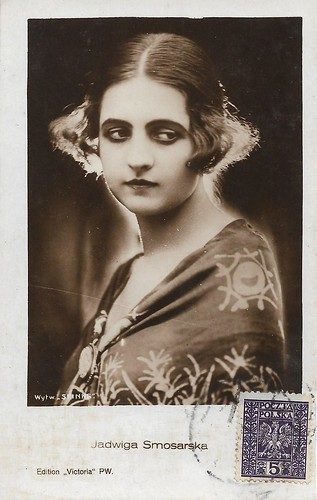
Polish postcard by Edition Victoria PW. Photo: Wytw. Sfinks.
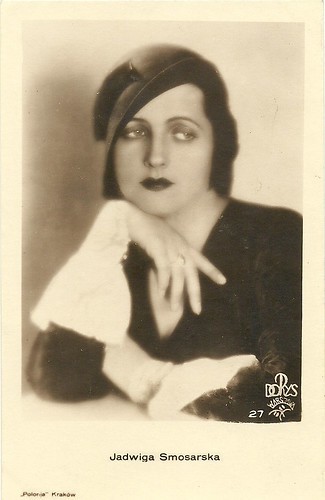
Polish postcard by Polonia, Krakòw, no. 27. Photo: Dorys, Warszawa (Warsaw). Collection: Didier Hanson.
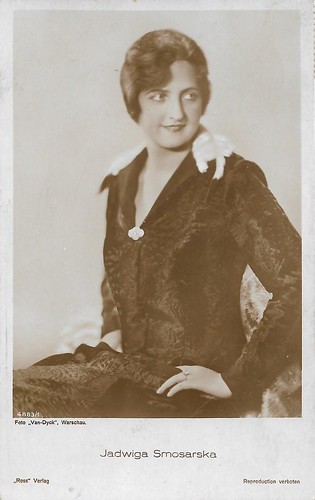
German postcard by Ross Verlag, no. 4883/1, 1929-1930. Photo: Van Dyck, Warsaw.
Sources: Wikipedia (Polish, Russian and English) and .

Polish postcard by BHK, no. 7. Photo: Sfinks. Jadwiga Smosarska in Tredowata/The Leper (Boleslaw Mierzejewski, Edward Puchalski, 1927). Collection: Didier Hanson.

German postcard by Ross Verlag, no. 3853/1, 1928-1929. Photo: W. Kirchnera, Warschau (Warsaw).

German postcard by Ross Verlag, no. 3853/2 1928-1929. Photo: Van-Dyck, Warschau (Warsaw). Collection: Didier Hanson.
Sarska
Jadwiga Filipina Smosarska was born in Warsaw as the daughter of Karol Smosarski, a chemist, and Waleria nee Darmos, a housewife and singer at charity concerts. She had three siblings, including two brothers.
Jadwiga spent her early childhood in the land estate of Jurka, where her father was the administrator. In 1905, the family moved to the capital. Five years later, father Karol died, and her mother had to earn a living for the children, working as a hairdresser.
As a teenage student, Jadwiga played in amateur performances. Her unofficial stage debut took place in 1916, in the role of the Virgin in Zygmunt Krasiński's 'Un-Divine Comedy', staged in the Polish Theatre by a student amateur group. After graduating in 1917, she studied acting with Władysław Staszkowski, and then enrolled for evening studies at the Warsaw Drama School, graduating with honours in 1920. In the meantime, she also earned her living by working at the Bank of Poland.
Under the pseudonym Sarska she made her debut in 1918 on the stage of the Summer Theatre in Warsaw in the farce 'Charley's Aunt'. In July 1920 she appeared in the diploma show of the Warsaw Drama School, and in September of the same year, she was involved in the Rozmaitosci Theatre team, where she worked until 1923. Her professional debut there was at the Summer Theater in the comedy 'Weteran' (Captain Swift), where she appeared together with Mieczysław Frenkel.
Until the Second World War, she would continue to perform at the stages of many Warsaw theaters, such as Rozmaitości (1920-1923), Polski and Mały (1924), Letni (1927), Narodowy, Nowy, Letni and Polski (1928-1939).

Polish postcard. Jadwiga Smosarska in Tredowata/The Leper (Edward Puchalski, Józef Węgrzyn 1926), adapted from the novel by Helena Mniszkówna. The man right of her is Léon Łuszcewski,

Polish postcard. Jadwiga Smosarska and Józef Wegrzyn.
The new star of the Sfinks
Jadwiga Smosarska's film debut was as Helena in Dla szczęścia/In the name of happiness (1919) by Aleksander Hertz, who then directed films at the company Sfinks.
After Pola Negri , the main star at Sfinks, had left for a career in Germany, Smosarska became the new star. English Wikipedia : "Smosarska was known for playing characters representative of Polish cliches that reflected the suffering of the country's citizens. Patriotic, romantic and in good social standing, her characters often struggled with malaise and a tragic love life."
Her famous titles included O czym sie nie mówi/The Unspeakable (Edward Puchalski, 1924), Tredowata/The Leper (Boleslaw Mierzejewski, Edward Puchalski, 1926) and the historical film Na Sybir/Exile to Siberia (Henryk Szaro, 1930). The latter was shot as a silent film, but a soundtrack was added in a Berlin studio.
Smosarska's passage to sound cinema went without obstacles, in contrast to others such as Irena Gawecka , whose film career ended because of the introduction of sound film. Smosarska starred in the historical film Barbara Radziwiłłówna (Józef Lejtes, 1936) which was the first feature film transmitted by Polish television during its test phase (on 26 August 1939).
Although she played in 26 Polish films, Smosarska more often appeared on the stages of Warsaw theatres, playing a total of 40 different plays. The cinema, however, brought her so much popularity that for many people (both audiences and critics) she was considered the biggest star of Polish pre-war cinema, winning in many popularity polls.

Polish postcard, no. Br 91811.

Polish postcard by H.P., no. 5220. Photo: Sfinks. Jadwiga Smosarska and Antoni Rozanski in Ziemia obiecana/The Promised Land (Zbigniew Gniazdowski, Aleksander Hertz, 1927). Collection: Didier Hanson.
A lucrative Hollywood contract
In 1932, Jadwiga Smosarska was discovered by Hollywood after her role in the period piece Księżna Łowicka (Mieczysław Krawicz, Janusz Warnecki, 1932), commemorating the Polish 1830-31 uprising.
However, the actress rejected a lucrative contract at one of the leading Hollywood majors because she did not want to leave Poland for a long time. In 1935, she married the engineer Zygmunt Protassewicz in the capital. The couple lived in a villa in Warsaw designed in accordance with Jadwiga's personal instructions. In 1938, she was awarded the Golden Cross of Merit: "in recognition of merits placed on the promotion of Polish film culture".
After the first bombings of Warsaw in September 1939, Smosarska and her husband fled to relatives in Lithuania. Subsequently, both of them arrived in Latvia, Sweden and Norway and in November 1939 in the USA, thanks to the proposal of Polish impresario Stanów Zjednoczonych, who had previously wanted to organise an American tour for her.
While the Hollywood industry would not accept her because of her accent, she appeared in the role of Julia in Aleksander Fredo's comedy 'Pierwszy Lepsza' (First Better), in the Polish Theatre of Artists in New York in the spring of 1944.
Around 1950, the couple lived in their own house with a garden in Middlebury, where Protassewicz ran a large precision tool factory. Polish emigrants and newcomers from Poland often visited them.
In 1954 Smosarska toured Canada to raise money for assisting Polish immigrants. After the war, she visited Poland several times and finally returned with her husband to her hometown for good in December 1970.
Jadwiga Smosarska died less than a year later, in 1971, in Warsaw because of agranulocytosis, an acute condition involving a severe and dangerous leukopenia (lowered white blood cell count). She was 73 and was buried in Aleja Zasłużonych at the local Powązki Cemetery.

Polish postcard by Edition Victoria PW. Photo: Wytw. Sfinks.

Polish postcard by Polonia, Krakòw, no. 27. Photo: Dorys, Warszawa (Warsaw). Collection: Didier Hanson.

German postcard by Ross Verlag, no. 4883/1, 1929-1930. Photo: Van Dyck, Warsaw.
Sources: Wikipedia (Polish, Russian and English) and .
Published on September 08, 2019 22:00
September 7, 2019
Carol Lynley (1942-2019)
Blond, blue-eyed American actress Carol Lynley, who starred in the The Poseidon Adventure (1972) and numerous other films, has died. She was 77. The actress, who had an attractively feline appeal, earned a Golden Globe nomination as a newcomer for Blue Denim (1959) about a naive teenager seeking an illegal abortion. It was a role she originated on Broadway. Last Friday, 3 September 2019, Lynley died in her sleep Tuesday in Los Angeles.
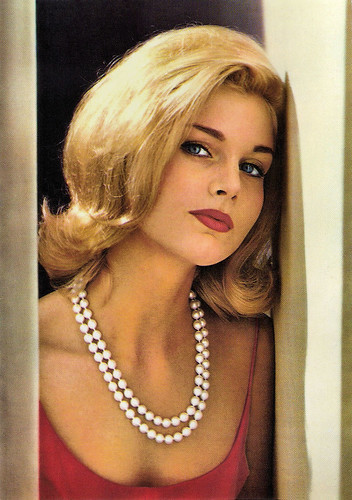
Italian postcard by Rotalfoto, Milano, no. N 159.
Wholesome ingénue roles and troubled teens
Carol Lynley was born Carole Ann Jones in 1942 in Manhattan, New York. Her parents were Cyril Jones and Frances Peltch.
She began her professional career as Carolyn Lee, a successful child model for the Sears & Roebuck department store in New York. Trying to branch out into acting early on, she discovered that another individual by that name (born seven years earlier) was already on the books of Actors' Equity, thus Carolyn changed her moniker by fusing the 'lyn' and the 'lee' to create 'Lynley'.
In April 1957, she was profiled by Life magazine and appeared on its cover. She was 15 years old and starring in the Broadway production 'The Potting Shed'.
Her first important film role came in The Light in the Forest (Herschel Daugherty, 1958) for Walt Disney Productions. It was a promising start and a New York Times reviewer praised her performance.
In 1958, she starred in the Broadway play 'Blue Denim' by writer James Leo Herlihy. It also starred Warren Berlinger and newcomer Burt Brinckerhoff in the lead male role. The play ran for 166 performances at the Playhouse Theatre.
The following year, the film version was released by 20th Century Fox Blue Denim (Philip Dunne, 1959) with Lynley and Berlinger reprising their stage roles, but with a 17-year-old Brandon deWilde in his first 'adult' role as the male lead Arthur Bartley. Dealing with the issues of teenage pregnancy and (then-illegal) abortion, both versions were not without controversy. The play and the film had different endings, and the word abortion in the play was not used in the screenplay
After Blue Denim, she went on to play other ingenue roles and troubled teens before gradually shedding her wholesome image by the early 1960s.
She then starred in Return to Peyton Place (José Ferrer, 1961), playing an author whose book revealing her New Hampshire hometown’s darkest secrets and scandals causes her and her family trouble. The film was based on a 1959 novel by Grace Metalious, a sequel to her best-selling 1956 novel 'Peyton Place'.
This was followed by the bawdy sex farce Under the Yum Yum Tree (David Swift, 1963), with Lynley as a virginal college student in a New York apartment block pursued by a lecherous landlord/playboy (Jack Lemmon). It gained Lemmon a Golden Globe nomination
Her acting mettle was proved with a double role opposite Tom Tryon and Romy Schneider in the drama The Cardinal (Otto Preminger, 1963), which was nominated for six Academy Awards, and as the tormented mother of a kidnapped child in the British psychological thriller Bunny Lake Is Missing (Otto Preminger, 1965) co-starring Laurence Olivier .
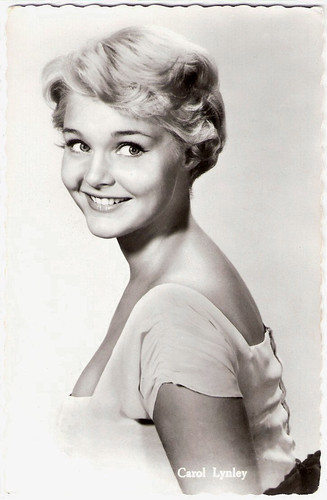
Dutch postcard. Photo: Universal International.
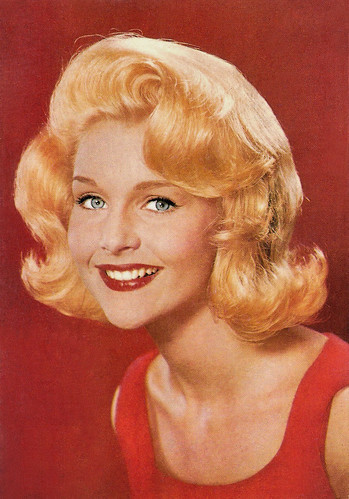
Spanish postcard by Postal Oscarcolor, no. 383.
Nude in Playboy magazine
In March 1965, Carol Lynley posed nude for an issue of Playboy magazine. That same year, she played the title role in Harlow (Alex Segal, 1965), a fictionalised biopic of 1930s Hollywood sex symbol Jean Harlow . This was Ginger Rogers', who played Harlow's mother, last film appearance.
The film was released shortly before a film with the same title and subject, Paramount's Harlow (Gordon Douglas, 1965), starring Carroll Baker . Wikipedia : "While Lynley was closer to Jean Harlow 's actual age than Baker, the film's contrived plot and visibly low budget prevented it from gaining as much attention as Paramount's big-budget version."
While the quality of her films tended to decline after the mid-1960s, there were still entertaining moments in B-pictures like The Shuttered Room (David Greene, 1967) and the lurid thriller Once You Kiss a Stranger... (Robert Sparr, 1969) as a psychotic murderess.
In Irwin Allen's The Poseidon Adventure (Ronald Neame, 1972), she was one of the ill-fated passengers, pop singer Nonnie Parry. Her character performs the song 'The Morning After', although the vocals were dubbed by studio singer Renee Armand. The song went on to win an Academy Award.
After 1967, television provided most of her work, including guest spots in seminal shows like Mannix (1967), The Invaders (1967), Hawaii Five-O (1968) and as co-star of the TV pilot for The Night Stalker (John Llewellyn Moxey, 1972) with Darren McGavin. Lynley also appeared in the fourth season of The Man from U.N.C.L.E. in the two-part episode The Prince of Darkness Affair (1967).
In her penultimate role, Lynley played a grandmother in a film with a very similar title to the one which had launched her career: A Light in the Forest (John Carl Buechler, 2003). In 2006, she appeared in Vic, a 30-minute film co-written and directed by Sage Stallone, the late son of Sylvester Stallone. Stallone won the 2006 Boston Film Festival 'Best New Filmmaker' award for the film, which was his debut.
After this film, Carol Lynley retired from screen acting. She had appeared in more than 100 films and television series.
Carol Lynley passed away on 3 September 2019 from a heart attack at the age of 77. She had been married to actor-producer and publicist Michael Selsman from 1960-1964, and they had one daughter, film maker Jill Selsman (1962). Lynley had an affair, off and on for 18 years, with English broadcaster and writer David Frost.
Trailer for Blue Denim (Philip Dunne, 1959) with an introduction by Joan Crawford. Source: Cliff Held (YouTube).
Theatrical trailer for the Carol Lynley version of Harlow (Alex Segal, 1965) co-starring Ginger Rogers, Efrem Zimbalist, Jr., Barry Sullivan and Hurd Hatfield. Source: W. David Lindholm (YouTube).
Trailer Bunny Lake Is Missing (Otto Preminger, 1965). Source: YouTube Movies (YouTube).
Trailer The Poseidon Adventure (Ronald Neame, 1972). Source: SPARTEN2 (YouTube).
Sources: (IMDb), Time, Wikipedia and .

Italian postcard by Rotalfoto, Milano, no. N 159.
Wholesome ingénue roles and troubled teens
Carol Lynley was born Carole Ann Jones in 1942 in Manhattan, New York. Her parents were Cyril Jones and Frances Peltch.
She began her professional career as Carolyn Lee, a successful child model for the Sears & Roebuck department store in New York. Trying to branch out into acting early on, she discovered that another individual by that name (born seven years earlier) was already on the books of Actors' Equity, thus Carolyn changed her moniker by fusing the 'lyn' and the 'lee' to create 'Lynley'.
In April 1957, she was profiled by Life magazine and appeared on its cover. She was 15 years old and starring in the Broadway production 'The Potting Shed'.
Her first important film role came in The Light in the Forest (Herschel Daugherty, 1958) for Walt Disney Productions. It was a promising start and a New York Times reviewer praised her performance.
In 1958, she starred in the Broadway play 'Blue Denim' by writer James Leo Herlihy. It also starred Warren Berlinger and newcomer Burt Brinckerhoff in the lead male role. The play ran for 166 performances at the Playhouse Theatre.
The following year, the film version was released by 20th Century Fox Blue Denim (Philip Dunne, 1959) with Lynley and Berlinger reprising their stage roles, but with a 17-year-old Brandon deWilde in his first 'adult' role as the male lead Arthur Bartley. Dealing with the issues of teenage pregnancy and (then-illegal) abortion, both versions were not without controversy. The play and the film had different endings, and the word abortion in the play was not used in the screenplay
After Blue Denim, she went on to play other ingenue roles and troubled teens before gradually shedding her wholesome image by the early 1960s.
She then starred in Return to Peyton Place (José Ferrer, 1961), playing an author whose book revealing her New Hampshire hometown’s darkest secrets and scandals causes her and her family trouble. The film was based on a 1959 novel by Grace Metalious, a sequel to her best-selling 1956 novel 'Peyton Place'.
This was followed by the bawdy sex farce Under the Yum Yum Tree (David Swift, 1963), with Lynley as a virginal college student in a New York apartment block pursued by a lecherous landlord/playboy (Jack Lemmon). It gained Lemmon a Golden Globe nomination
Her acting mettle was proved with a double role opposite Tom Tryon and Romy Schneider in the drama The Cardinal (Otto Preminger, 1963), which was nominated for six Academy Awards, and as the tormented mother of a kidnapped child in the British psychological thriller Bunny Lake Is Missing (Otto Preminger, 1965) co-starring Laurence Olivier .

Dutch postcard. Photo: Universal International.

Spanish postcard by Postal Oscarcolor, no. 383.
Nude in Playboy magazine
In March 1965, Carol Lynley posed nude for an issue of Playboy magazine. That same year, she played the title role in Harlow (Alex Segal, 1965), a fictionalised biopic of 1930s Hollywood sex symbol Jean Harlow . This was Ginger Rogers', who played Harlow's mother, last film appearance.
The film was released shortly before a film with the same title and subject, Paramount's Harlow (Gordon Douglas, 1965), starring Carroll Baker . Wikipedia : "While Lynley was closer to Jean Harlow 's actual age than Baker, the film's contrived plot and visibly low budget prevented it from gaining as much attention as Paramount's big-budget version."
While the quality of her films tended to decline after the mid-1960s, there were still entertaining moments in B-pictures like The Shuttered Room (David Greene, 1967) and the lurid thriller Once You Kiss a Stranger... (Robert Sparr, 1969) as a psychotic murderess.
In Irwin Allen's The Poseidon Adventure (Ronald Neame, 1972), she was one of the ill-fated passengers, pop singer Nonnie Parry. Her character performs the song 'The Morning After', although the vocals were dubbed by studio singer Renee Armand. The song went on to win an Academy Award.
After 1967, television provided most of her work, including guest spots in seminal shows like Mannix (1967), The Invaders (1967), Hawaii Five-O (1968) and as co-star of the TV pilot for The Night Stalker (John Llewellyn Moxey, 1972) with Darren McGavin. Lynley also appeared in the fourth season of The Man from U.N.C.L.E. in the two-part episode The Prince of Darkness Affair (1967).
In her penultimate role, Lynley played a grandmother in a film with a very similar title to the one which had launched her career: A Light in the Forest (John Carl Buechler, 2003). In 2006, she appeared in Vic, a 30-minute film co-written and directed by Sage Stallone, the late son of Sylvester Stallone. Stallone won the 2006 Boston Film Festival 'Best New Filmmaker' award for the film, which was his debut.
After this film, Carol Lynley retired from screen acting. She had appeared in more than 100 films and television series.
Carol Lynley passed away on 3 September 2019 from a heart attack at the age of 77. She had been married to actor-producer and publicist Michael Selsman from 1960-1964, and they had one daughter, film maker Jill Selsman (1962). Lynley had an affair, off and on for 18 years, with English broadcaster and writer David Frost.
Trailer for Blue Denim (Philip Dunne, 1959) with an introduction by Joan Crawford. Source: Cliff Held (YouTube).
Theatrical trailer for the Carol Lynley version of Harlow (Alex Segal, 1965) co-starring Ginger Rogers, Efrem Zimbalist, Jr., Barry Sullivan and Hurd Hatfield. Source: W. David Lindholm (YouTube).
Trailer Bunny Lake Is Missing (Otto Preminger, 1965). Source: YouTube Movies (YouTube).
Trailer The Poseidon Adventure (Ronald Neame, 1972). Source: SPARTEN2 (YouTube).
Sources: (IMDb), Time, Wikipedia and .
Published on September 07, 2019 22:00
September 6, 2019
The Collecciones Amatller Series
For already more than 200 years, Amatller chocolates are produced in the Spanish city of Barcelona. Since 1797, Chocolate Amatller has used a great variety of advertising messages. In 1972, Chocolate Simón Coll bought Amatller, and it still produces various Amattler boxes and tins with chocolates. Between the end of the 19th Century and the first half of the 20th, Amatller published collectors cards to promote and market their chocolates. The Spanish chocolaterie presented several series of cards that dealt with films and film stars. Earlier we did posts on sets with tinted black and white cards for the Italian silent films Tosca (Alfredo De Antoni, 1918) and Fabiola (Enrico Guazzoni, 1918). Today, EFSP presents a selection of the series 'Collecciones Amatller' with colourful cards from the early 1920s with both American and European film stars and film scenes.
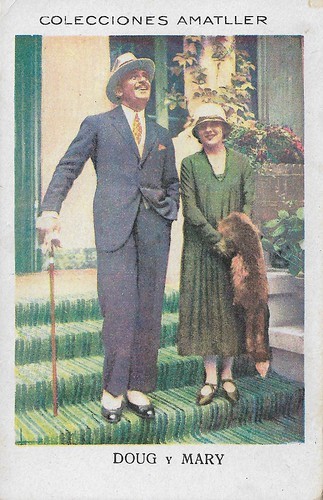
Spanish collectors card in the Collecciones Amatller Series, Serie A, artist no. 1 and 2, no. 8, by Chocolate Amatller.
Mary Pickford (1892-1979) was a legendary silent film actress and was known as 'America’s sweetheart.' She was the co-founder of United Artists and helped establish the AMPAS (Academy of Motion Pictures and Sciences). American actor Douglas Fairbanks (1883-1939) was best known for his swashbuckling roles in silent films such as The Mark of Zorro (1920), Robin Hood (1922), and The Thief of Bagdad (1924), but spent the early part of his career making comedies. Fairbanks was a founding member of United Artists and of The Motion Picture Academy. He hosted the first Oscars Ceremony in 1929. With his marriage to Mary Pickford in 1920, the couple became Hollywood royalty and Fairbanks was referred to as 'The King of Hollywood', but his career rapidly declined with the advent of the 'talkies'. He made his final film in Great Britain, The Private Life of Don Juan (1934).
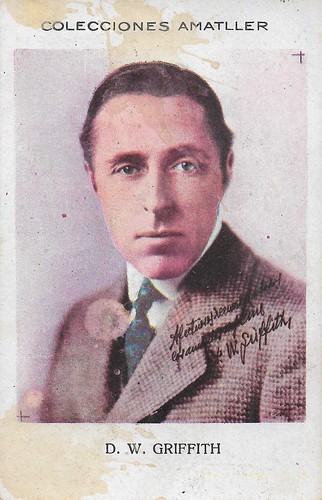
Spanish collectors card in the Collecciones Amatller Series, Serie B, artist no. 3, no. 10, by Chocolate Amatller.
David Wark Griffith (1875–1948) was an American director, writer, and producer who pioneered modern cinematic techniques. After shooting hundreds of shorts at Biograph, he made his mark with his features The Birth of a Nation (1915) and Intolerance (1916), both acclaimed for their radical camera and narrative techniques, while the first has also been condemned for its inherently racist philosophy. Several of Griffith's later films were also successful, including Broken Blossoms (1919), Way Down East (1920), and Orphans of the Storm (1921), but his high costs for production, promotion, and roadshow often made his ventures commercial failures. Griffith was one of the co-founders of United Artists and of AMPAS (Academy of Motion Pictures and Sciences).
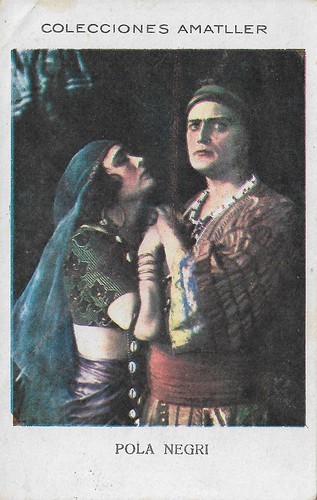
Spanish collectors card in the Collecciones Amatller Series, Series C, artist no. 4, no. 13, by Chocolate Amatller. Photo: Pola Negri and Harry Liedtke in the German silent film Sumurun (Ernst Lubitsch, 1920).
Ernst Lubitsch's silent film Sumurun tell the story of the favorite slave girl ( Jenny Hasselquist ) of a tyrannical sheik ( Paul Wegener ), who falls in love with a cloth merchant (Harry Liedtke). Meanwhile, a hunchback clown (Ernst Lubitsch himself) suffers unrequited love for a traveling dancer ( Pola Negri ) who wants to join the harem. Polish film actress Pola Negri (1897-1987) achieved notoriety as a femme fatale in German and American silent films between the 1910s and 1930s. German actor Harry Liedtke (1882-1945) was the charming ladykiller of many early silent classics. Detective serials like Joe Deebs made him one of the first male stars of the German cinema.
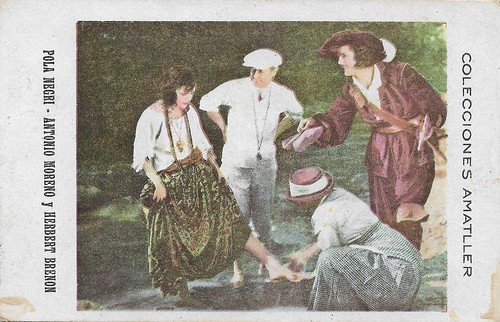
Spanish collectors card in the Collecciones Amatller Series, Series C, artist no. 4, no. 18, by Chocolate Amatller. Photo: Pola Negri , Antonio Moreno and director Herbert Brenon while shooting the silent film The Spanish Dancer (Herbert Brenon, 1923).
Polish film actress Pola Negri (1897-1987) achieved notoriety as a femme fatale in German and American silent films between the 1910s and 1930s. Antonio 'Tony' Moreno (1887-1967) was a Spanish-born American actor and film director of the silent film era and through the 1950s. In his early films, Moreno was often typecast as the 'Latin Lover'. He is best known for films such as The Spanish Dancer (1923), Mare Nostrum (1926) with Alice Terry, The Temptress (1926) with Greta Garbo , and It (1927) with Clara Bow.
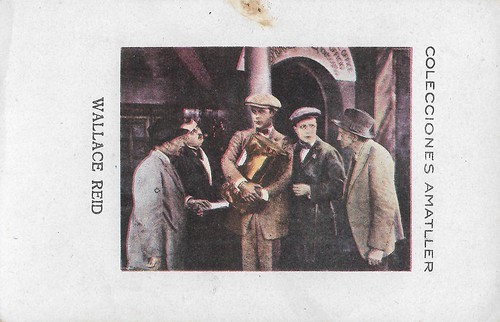
Spanish collectors card in the Collecciones Amatller Series, Series CC, artist 35, no. 77, by Chocolate Amatller. Photo: Wallace Reid and Harrison Ford in Hawthorne of the U.S.A. (James Cruze, 1919). It is one of the few surviving films with Reid.
Wallace Reid (1891–1923) was an American actor in silent film referred to as "the screen's most perfect lover". Born in a vaudeville family, he became an all-around athlete and gifted musician. When his father entered the film business in 1910, he brought along his teenage son, who debuted at Selig but soon rose to popularity at Vitagraph. After some 100 shorts and parts in films like Birth of a nation and Intolerance by Griffith, Paramount hired him for some 60 more films, including some dashing fast car films (Reid was so fond of racing, he even joined an Indianapolis race). By the 1920s, Reid was one of Hollywood's major heartthrobs. En route to Oregon for a film shooting in 1919, he was injured in a train wreck and took morphine to continue filming. This led to an addiction, which in the end killed him, in 1923, at the age of only 31. His wife, the actress Dorothy Davenport, afterward, did a national tour to warn against the dangers of drugs.
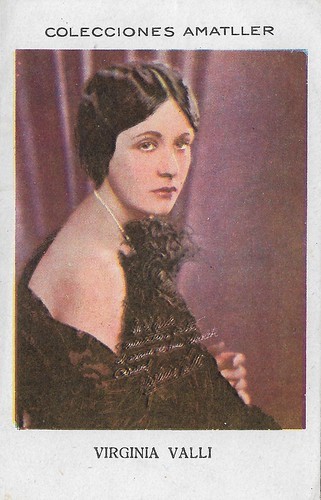
Spanish collectors card in the Collecciones Amatller Series, Series CCC, artist no. 69, no. 123, by Chocolate Amatller.
Virginia Valli (1895–1968) was an American stage and film actress whose motion picture career started in the silent film era and lasted until the beginning of the sound film era of the 1930s.
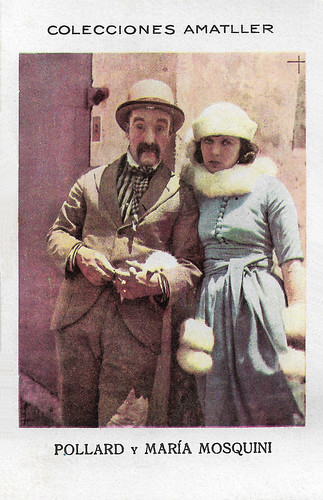
Spanish collectors card in the Collecciones Amatller Series, Serie CH, artist no. 6, no. 21, by Chocolate Amatller.
Australian born comedian Snub Pollard (1889-1962) with his walrus moustache was one of the well known faces of the Hal Roach company during the 1910s. His inseparable leading lady in many Hal Roach comedies was pert, slightly-built comedienne Maria Mosquini (1899-1983).
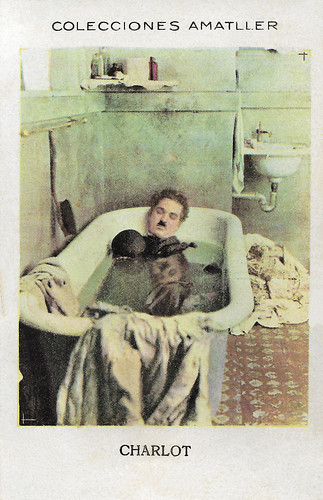
Spanish collectors card in the Collecciones Amatller Series, Serie D, artist no. 7, no. 26, by Chocolate Amatller. Photo: Charlie Chaplin in Pay Day (Charles Chaplin, 1922).
English comedian Charles ‘Charlie’ Chaplin (1889-1977) was one of the most creative and influential personalities of the silent-film era. His most famous role was that of The Tramp with his toothbrush mustache, undersized bowler hat and bamboo cane who struggled to survive while keeping his dignity in a world with great social injustice. Chaplin used mime, slapstick and other visual comedy routines, and he not only starred in his films, but also directed, wrote and produced them, and composed the music as well. His working life in entertainment spanned over 75 years, from the Victorian stage and the Music Hall in the United Kingdom as a child performer, until close to his death at the age of 88. Author George Bernard Shaw called Chaplin "the only genius to come out of the movie industry".
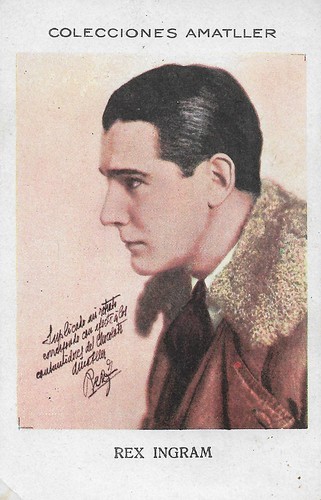
Spanish collectors card in the Collecciones Amatller Series, Series EE, artist no. 40, no. 82, by Chocolate Amatller.
Irish born Rex Ingram (1892-1950) was a film director, producer, writer and actor in Hollywood who was responsible for a succession of silent films for Metro Pictures, later M-G-M, that topped the box office and were hailed as masterpieces by the critics. He made a star of Rudolph Valentino with The Four Horsemen of the Apocalypse (1921). When they fell out, he found a new heartthrob in Ramon Novarro , who debuted with Ingram in The Prisoner of Zenda (1922). Rex’s second marriage, to Alice Terry, saw him cast her in the lead in all but one of his films. Director Erich von Stroheim once called him "the world's greatest director".
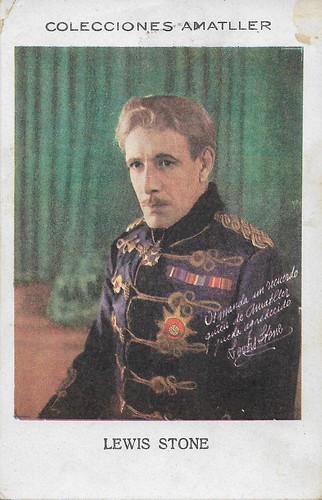
Spanish collectors card in the Collecciones Amatller Series, Series EE, artist no. 41, no. 83, by Chocolate Amatller. Photo: Lewis Stone in The Prisoner of Zenda (Rex Ingram, 1922).
Lewis Stone (1879–1953) was an American movie actor best known for his role as Judge James Hardy in the MGM Andy Hardy film series (1937-1946) and as a studio contract player. Stone had started acting in films in the mid-1910s. He was nominated for the Academy Award for Best Actor in 1929 for The Patriot. He appeared in seven films with Greta Garbo , including Grand Hotel (1932) and Queen Christina (1933), and also had a major part as the Warden in the Pre-Code movie The Big House (1930). After The Prisoner of Zenda, Stone did two more films with Rex Ingram : Trifling Women (1922) with Barbara La Marr and Ramon Novarro , and Scaramouche (1923) with Novarro and Alice Terry. Oddly enough two of his last parts were in remakes of Scaramouche and The Prisoner of Zenda, both 1952.
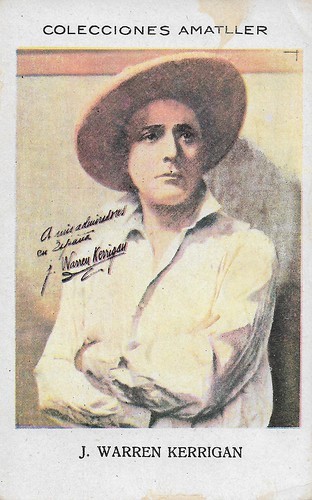
Spanish collectors card in the Collecciones Amatller Series, Series G, artist no. 10, no. 32, by Chocolate Amatller.
J. (Jack) Warren Kerrigan (1879-1947) was an American actor of the silent screen. From 1910, he had a most active career first in shorts at Essanay, American at Victor, then in features at Universal. After a gap in the early 1920s, he came back with a bang in James Cruze's The Covered Wagon (1923) but stopped acting in 1924 after a car accident.
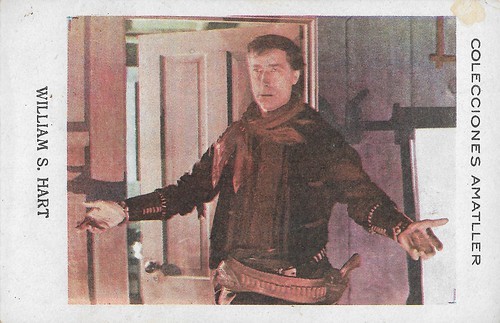
Spanish collectors card in the Collecciones Amatller Series, Series HH, artist no. 44, no. 87, by Chocolate Amatller. Photo: Amattler.
William S. [Surrey] Hart (1864–1946) was an American silent film actor, screenwriter, director, and producer. He entered films in 1914 where, after playing supporting roles in two short films, he achieved stardom as the lead in The Bargain (Reginald Barker, 1914), his first Western. He became a foremost Western star of the silent era who played characters with honor and integrity. Hart was particularly interested in making realistic Westerns, and his films are noted for their authentic costumes and props. Hart also had an extraordinary acting ability, honed on Shakespearean theatre stages in the United States and the UK.
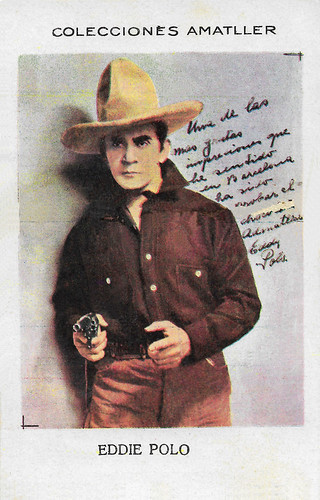
Spanish collectors card in the Collecciones Amatller Series, Serie I, Artista no. 12, no. 34, by Chocolate Amatller. Photo: Amattler.
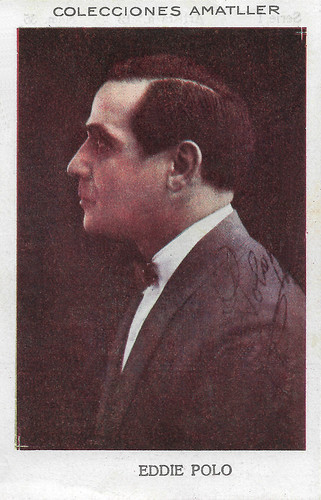
Spanish collectors card in the Collecciones Amatller Series, Serie I, artist no. 12, no. 35, by Chocolate Amatller. Photo: Amatller.
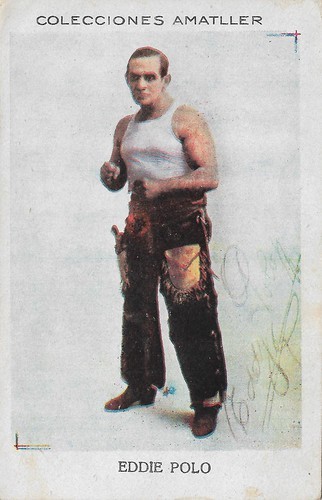
Spanish collectors card in the Collecciones Amatller Series, Series I, artist no. 12, no. 36, by Chocolate Amatller.
Eddie Polo (1875–1961) was an Austro-American actor of the silent era. He was born Edward W. Wyman or Weimer in Vienna, Austria-Hungary. With his brother Sam he was the trapeze act The Flying Cordovas. He was the first man to parachute off the Eiffel Tower. Beginning in 1913, he appeared in serials and films in the USA and as Cyclone Smith, he became a popular Western hero. During the late 1920s, he was an action star in the German silent cinema. After his acting career ended in the mid-1940s he worked as a makeup artist.
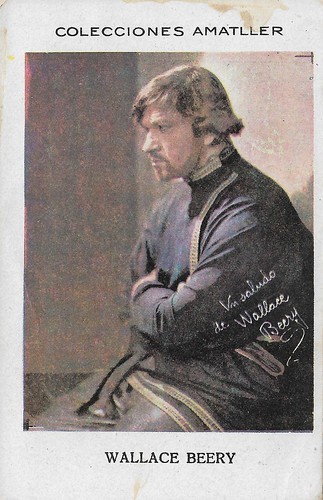
Spanish collectors card in the Collecciones Amatller Series, Series J, artist no. 13, no. 39, by Chocolate Amatller. Photo: Wallace Beery in Bavu (Stuart Paton, 1923).
American actor Wallace Beery (1885-1949) is best known for his portrayal of Bill in Min and Bill opposite Marie Dressler, as Long John Silver in Treasure Island, as Pancho Villa in Viva Villa!, and his titular role in The Champ, for which he won the Academy Award for Best Actor. Beery appeared in some 250 films in a 36-year career. He was the brother of actor Noah Beery, Sr. and uncle of actor Noah Beery, Jr.
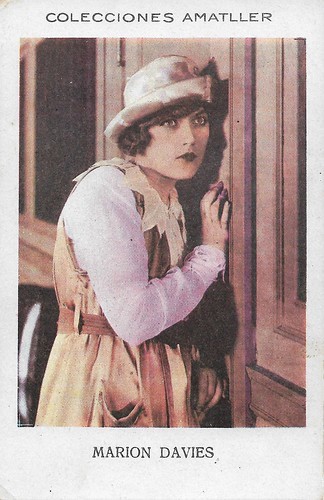
Spanish collectors card in the Collecciones Amatller Series, Series KK, artist no. 48, no. 94, by Chocolate Amatller.
Marion Davies (1897-1961) was one of the great comedic actresses of the silent era. She starred in nearly four dozen films between 1917 and 1937.
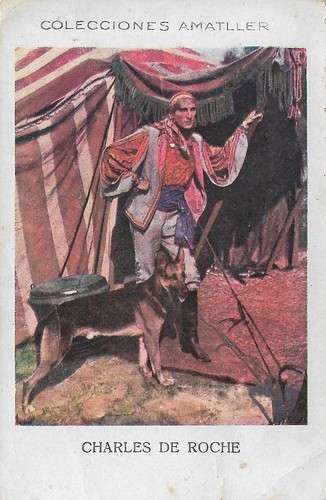
Spanish collectors card in the Collecciones Amatller Series, Series N, artist 19, no. 50, by Chocolate Amatller. Photo: Charles de Roche[fort] in Law of the Lawless (Victor Fleming, 1923).
Charles de Rochefort (1887-1952) was a star of the French silent cinema. He appeared in 34 films between 1911 and 1932. In 1923 he went to the US, where he was known as Charles de Roche and starred in several films in Hollywood, e.g. as pharaon Rameses in The Ten Commandments (DeMille 1923). After his return to France, he became a film director of sound films.
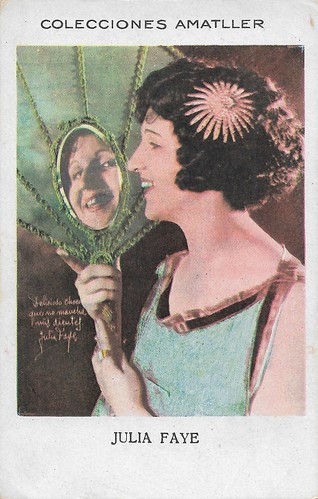
Spanish collectors card in the Collecciones Amatller Series, Series NN, artist no. 54, no. 100, by Chocolate Amatller.
Julia Faye (1892–1966) was an American film actress. Her career is inextricably linked to director Cecil B. DeMille. He was her mentor, while she was for many years his mistress. Their liaison was tolerated by De Mille's long-suffering wife Constance Adams. She was featured in billed supporting roles in a number of De Mille's big-budget extravaganzas, including The Ten Commandments (1923) (as Pharaoh's wife), The Volga Boatsman (1926) (as a gypsy) and The King of Kings (1927) (as Martha).
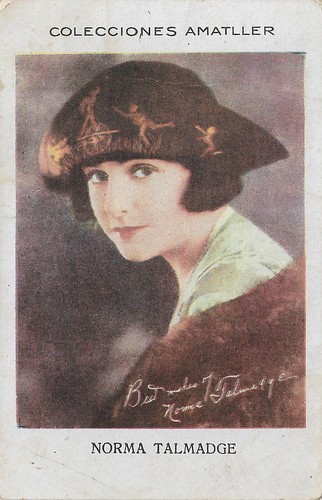
Spanish collectors card in the Collecciones Amatller Series, Series QQ, artist no. 58, no. 106, by Chocolate Amatller.
Norma Talmadge (1894–1957) was an American actress and film producer of the silent era. A major box-office draw for more than a decade, her career reached a peak in the early 1920s, when she ranked among the most popular idols of the American screen.
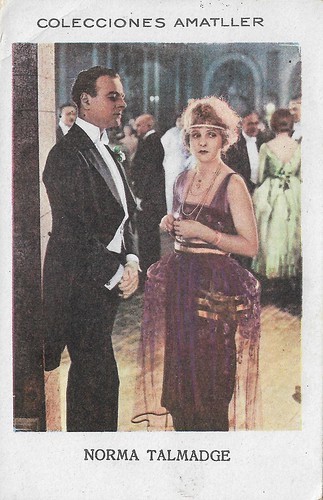
Spanish collectors card in the Collecciones Amatller Series, Series QQ, artist no. 58, no. 107, by Chocolate Amatller. Photo: Norma Talmadge and Lowell Sherman in Yes or No? (Roy William Neill, 1920).
Norma Talmadge (1894–1957) was an American actress and film producer of the silent era. A major box-office draw for more than a decade, her career reached a peak in the early 1920s, when she ranked among the most popular idols of the American screen.
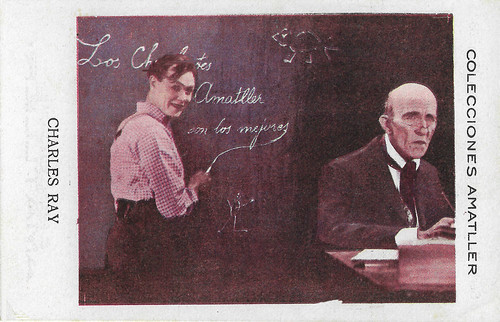
Spanish collectors card in the Collecciones Amatller Series, Serie X, artist no. 28, no. 63, by Chocolate Amatller. Photo: United Artists. Charles Ray and Lon Poff in The Old Swimmin' Hole (Joe de Grasse, 1921).
Charles Ray (1891-1943) was an American actor, scriptwriter, and director of the silent screen, who knew a parabole from rags to riches and back again. He worked for Paramount, his own company, United Artists and MGM. In the late 1910s and early 1920s, he was a very popular actor and one of Hollywood's best-paid stars.

Spanish collectors card in the Collecciones Amatller Series, Serie A, artist no. 1 and 2, no. 8, by Chocolate Amatller.
Mary Pickford (1892-1979) was a legendary silent film actress and was known as 'America’s sweetheart.' She was the co-founder of United Artists and helped establish the AMPAS (Academy of Motion Pictures and Sciences). American actor Douglas Fairbanks (1883-1939) was best known for his swashbuckling roles in silent films such as The Mark of Zorro (1920), Robin Hood (1922), and The Thief of Bagdad (1924), but spent the early part of his career making comedies. Fairbanks was a founding member of United Artists and of The Motion Picture Academy. He hosted the first Oscars Ceremony in 1929. With his marriage to Mary Pickford in 1920, the couple became Hollywood royalty and Fairbanks was referred to as 'The King of Hollywood', but his career rapidly declined with the advent of the 'talkies'. He made his final film in Great Britain, The Private Life of Don Juan (1934).

Spanish collectors card in the Collecciones Amatller Series, Serie B, artist no. 3, no. 10, by Chocolate Amatller.
David Wark Griffith (1875–1948) was an American director, writer, and producer who pioneered modern cinematic techniques. After shooting hundreds of shorts at Biograph, he made his mark with his features The Birth of a Nation (1915) and Intolerance (1916), both acclaimed for their radical camera and narrative techniques, while the first has also been condemned for its inherently racist philosophy. Several of Griffith's later films were also successful, including Broken Blossoms (1919), Way Down East (1920), and Orphans of the Storm (1921), but his high costs for production, promotion, and roadshow often made his ventures commercial failures. Griffith was one of the co-founders of United Artists and of AMPAS (Academy of Motion Pictures and Sciences).

Spanish collectors card in the Collecciones Amatller Series, Series C, artist no. 4, no. 13, by Chocolate Amatller. Photo: Pola Negri and Harry Liedtke in the German silent film Sumurun (Ernst Lubitsch, 1920).
Ernst Lubitsch's silent film Sumurun tell the story of the favorite slave girl ( Jenny Hasselquist ) of a tyrannical sheik ( Paul Wegener ), who falls in love with a cloth merchant (Harry Liedtke). Meanwhile, a hunchback clown (Ernst Lubitsch himself) suffers unrequited love for a traveling dancer ( Pola Negri ) who wants to join the harem. Polish film actress Pola Negri (1897-1987) achieved notoriety as a femme fatale in German and American silent films between the 1910s and 1930s. German actor Harry Liedtke (1882-1945) was the charming ladykiller of many early silent classics. Detective serials like Joe Deebs made him one of the first male stars of the German cinema.

Spanish collectors card in the Collecciones Amatller Series, Series C, artist no. 4, no. 18, by Chocolate Amatller. Photo: Pola Negri , Antonio Moreno and director Herbert Brenon while shooting the silent film The Spanish Dancer (Herbert Brenon, 1923).
Polish film actress Pola Negri (1897-1987) achieved notoriety as a femme fatale in German and American silent films between the 1910s and 1930s. Antonio 'Tony' Moreno (1887-1967) was a Spanish-born American actor and film director of the silent film era and through the 1950s. In his early films, Moreno was often typecast as the 'Latin Lover'. He is best known for films such as The Spanish Dancer (1923), Mare Nostrum (1926) with Alice Terry, The Temptress (1926) with Greta Garbo , and It (1927) with Clara Bow.

Spanish collectors card in the Collecciones Amatller Series, Series CC, artist 35, no. 77, by Chocolate Amatller. Photo: Wallace Reid and Harrison Ford in Hawthorne of the U.S.A. (James Cruze, 1919). It is one of the few surviving films with Reid.
Wallace Reid (1891–1923) was an American actor in silent film referred to as "the screen's most perfect lover". Born in a vaudeville family, he became an all-around athlete and gifted musician. When his father entered the film business in 1910, he brought along his teenage son, who debuted at Selig but soon rose to popularity at Vitagraph. After some 100 shorts and parts in films like Birth of a nation and Intolerance by Griffith, Paramount hired him for some 60 more films, including some dashing fast car films (Reid was so fond of racing, he even joined an Indianapolis race). By the 1920s, Reid was one of Hollywood's major heartthrobs. En route to Oregon for a film shooting in 1919, he was injured in a train wreck and took morphine to continue filming. This led to an addiction, which in the end killed him, in 1923, at the age of only 31. His wife, the actress Dorothy Davenport, afterward, did a national tour to warn against the dangers of drugs.

Spanish collectors card in the Collecciones Amatller Series, Series CCC, artist no. 69, no. 123, by Chocolate Amatller.
Virginia Valli (1895–1968) was an American stage and film actress whose motion picture career started in the silent film era and lasted until the beginning of the sound film era of the 1930s.

Spanish collectors card in the Collecciones Amatller Series, Serie CH, artist no. 6, no. 21, by Chocolate Amatller.
Australian born comedian Snub Pollard (1889-1962) with his walrus moustache was one of the well known faces of the Hal Roach company during the 1910s. His inseparable leading lady in many Hal Roach comedies was pert, slightly-built comedienne Maria Mosquini (1899-1983).

Spanish collectors card in the Collecciones Amatller Series, Serie D, artist no. 7, no. 26, by Chocolate Amatller. Photo: Charlie Chaplin in Pay Day (Charles Chaplin, 1922).
English comedian Charles ‘Charlie’ Chaplin (1889-1977) was one of the most creative and influential personalities of the silent-film era. His most famous role was that of The Tramp with his toothbrush mustache, undersized bowler hat and bamboo cane who struggled to survive while keeping his dignity in a world with great social injustice. Chaplin used mime, slapstick and other visual comedy routines, and he not only starred in his films, but also directed, wrote and produced them, and composed the music as well. His working life in entertainment spanned over 75 years, from the Victorian stage and the Music Hall in the United Kingdom as a child performer, until close to his death at the age of 88. Author George Bernard Shaw called Chaplin "the only genius to come out of the movie industry".

Spanish collectors card in the Collecciones Amatller Series, Series EE, artist no. 40, no. 82, by Chocolate Amatller.
Irish born Rex Ingram (1892-1950) was a film director, producer, writer and actor in Hollywood who was responsible for a succession of silent films for Metro Pictures, later M-G-M, that topped the box office and were hailed as masterpieces by the critics. He made a star of Rudolph Valentino with The Four Horsemen of the Apocalypse (1921). When they fell out, he found a new heartthrob in Ramon Novarro , who debuted with Ingram in The Prisoner of Zenda (1922). Rex’s second marriage, to Alice Terry, saw him cast her in the lead in all but one of his films. Director Erich von Stroheim once called him "the world's greatest director".

Spanish collectors card in the Collecciones Amatller Series, Series EE, artist no. 41, no. 83, by Chocolate Amatller. Photo: Lewis Stone in The Prisoner of Zenda (Rex Ingram, 1922).
Lewis Stone (1879–1953) was an American movie actor best known for his role as Judge James Hardy in the MGM Andy Hardy film series (1937-1946) and as a studio contract player. Stone had started acting in films in the mid-1910s. He was nominated for the Academy Award for Best Actor in 1929 for The Patriot. He appeared in seven films with Greta Garbo , including Grand Hotel (1932) and Queen Christina (1933), and also had a major part as the Warden in the Pre-Code movie The Big House (1930). After The Prisoner of Zenda, Stone did two more films with Rex Ingram : Trifling Women (1922) with Barbara La Marr and Ramon Novarro , and Scaramouche (1923) with Novarro and Alice Terry. Oddly enough two of his last parts were in remakes of Scaramouche and The Prisoner of Zenda, both 1952.

Spanish collectors card in the Collecciones Amatller Series, Series G, artist no. 10, no. 32, by Chocolate Amatller.
J. (Jack) Warren Kerrigan (1879-1947) was an American actor of the silent screen. From 1910, he had a most active career first in shorts at Essanay, American at Victor, then in features at Universal. After a gap in the early 1920s, he came back with a bang in James Cruze's The Covered Wagon (1923) but stopped acting in 1924 after a car accident.

Spanish collectors card in the Collecciones Amatller Series, Series HH, artist no. 44, no. 87, by Chocolate Amatller. Photo: Amattler.
William S. [Surrey] Hart (1864–1946) was an American silent film actor, screenwriter, director, and producer. He entered films in 1914 where, after playing supporting roles in two short films, he achieved stardom as the lead in The Bargain (Reginald Barker, 1914), his first Western. He became a foremost Western star of the silent era who played characters with honor and integrity. Hart was particularly interested in making realistic Westerns, and his films are noted for their authentic costumes and props. Hart also had an extraordinary acting ability, honed on Shakespearean theatre stages in the United States and the UK.

Spanish collectors card in the Collecciones Amatller Series, Serie I, Artista no. 12, no. 34, by Chocolate Amatller. Photo: Amattler.

Spanish collectors card in the Collecciones Amatller Series, Serie I, artist no. 12, no. 35, by Chocolate Amatller. Photo: Amatller.

Spanish collectors card in the Collecciones Amatller Series, Series I, artist no. 12, no. 36, by Chocolate Amatller.
Eddie Polo (1875–1961) was an Austro-American actor of the silent era. He was born Edward W. Wyman or Weimer in Vienna, Austria-Hungary. With his brother Sam he was the trapeze act The Flying Cordovas. He was the first man to parachute off the Eiffel Tower. Beginning in 1913, he appeared in serials and films in the USA and as Cyclone Smith, he became a popular Western hero. During the late 1920s, he was an action star in the German silent cinema. After his acting career ended in the mid-1940s he worked as a makeup artist.

Spanish collectors card in the Collecciones Amatller Series, Series J, artist no. 13, no. 39, by Chocolate Amatller. Photo: Wallace Beery in Bavu (Stuart Paton, 1923).
American actor Wallace Beery (1885-1949) is best known for his portrayal of Bill in Min and Bill opposite Marie Dressler, as Long John Silver in Treasure Island, as Pancho Villa in Viva Villa!, and his titular role in The Champ, for which he won the Academy Award for Best Actor. Beery appeared in some 250 films in a 36-year career. He was the brother of actor Noah Beery, Sr. and uncle of actor Noah Beery, Jr.

Spanish collectors card in the Collecciones Amatller Series, Series KK, artist no. 48, no. 94, by Chocolate Amatller.
Marion Davies (1897-1961) was one of the great comedic actresses of the silent era. She starred in nearly four dozen films between 1917 and 1937.

Spanish collectors card in the Collecciones Amatller Series, Series N, artist 19, no. 50, by Chocolate Amatller. Photo: Charles de Roche[fort] in Law of the Lawless (Victor Fleming, 1923).
Charles de Rochefort (1887-1952) was a star of the French silent cinema. He appeared in 34 films between 1911 and 1932. In 1923 he went to the US, where he was known as Charles de Roche and starred in several films in Hollywood, e.g. as pharaon Rameses in The Ten Commandments (DeMille 1923). After his return to France, he became a film director of sound films.

Spanish collectors card in the Collecciones Amatller Series, Series NN, artist no. 54, no. 100, by Chocolate Amatller.
Julia Faye (1892–1966) was an American film actress. Her career is inextricably linked to director Cecil B. DeMille. He was her mentor, while she was for many years his mistress. Their liaison was tolerated by De Mille's long-suffering wife Constance Adams. She was featured in billed supporting roles in a number of De Mille's big-budget extravaganzas, including The Ten Commandments (1923) (as Pharaoh's wife), The Volga Boatsman (1926) (as a gypsy) and The King of Kings (1927) (as Martha).

Spanish collectors card in the Collecciones Amatller Series, Series QQ, artist no. 58, no. 106, by Chocolate Amatller.
Norma Talmadge (1894–1957) was an American actress and film producer of the silent era. A major box-office draw for more than a decade, her career reached a peak in the early 1920s, when she ranked among the most popular idols of the American screen.

Spanish collectors card in the Collecciones Amatller Series, Series QQ, artist no. 58, no. 107, by Chocolate Amatller. Photo: Norma Talmadge and Lowell Sherman in Yes or No? (Roy William Neill, 1920).
Norma Talmadge (1894–1957) was an American actress and film producer of the silent era. A major box-office draw for more than a decade, her career reached a peak in the early 1920s, when she ranked among the most popular idols of the American screen.

Spanish collectors card in the Collecciones Amatller Series, Serie X, artist no. 28, no. 63, by Chocolate Amatller. Photo: United Artists. Charles Ray and Lon Poff in The Old Swimmin' Hole (Joe de Grasse, 1921).
Charles Ray (1891-1943) was an American actor, scriptwriter, and director of the silent screen, who knew a parabole from rags to riches and back again. He worked for Paramount, his own company, United Artists and MGM. In the late 1910s and early 1920s, he was a very popular actor and one of Hollywood's best-paid stars.
Published on September 06, 2019 22:00
September 5, 2019
Charles Bickford
Charles Bickford (1891-1967) was an American character actor of gruff voice and appearance. He was nominated three times for the Academy Award for Best Supporting Actor, for The Song of Bernadette (1943), The Farmer's Daughter (1947), and Johnny Belinda (1948). Other notable roles include Anna Christie (1930), Whirlpool (1948), A Star is Born (1954), and The Big Country (1958).
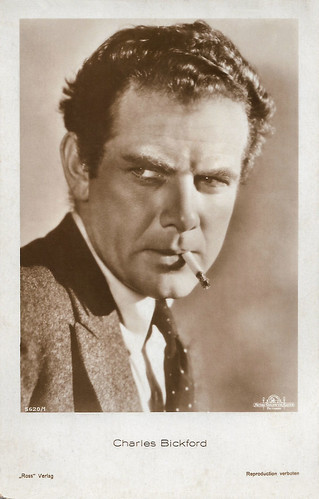
German postcard by Ross Verlag, no. 5620/1, 1930-1931. Photo: Metro-Goldwyn-Mayer.
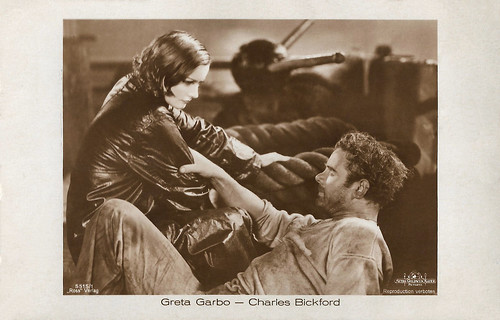
German postcard by Ross Verlag, no. 5515/1. Photo: MGM. Greta Garbo and Charles Bickford in Anna Christie (Clarence Brown, 1930).
Tried and acquitted of the attempted murder at age nine
Charles Ambrose Bickford was born in Cambridge, Massachusetts, during the first minute of 1891. His parents were Loretus and Mary Ellen Bickford. The fifth of seven children, he was an intelligent but very independent and unruly child. He had a particularly strong relationship with his maternal grandfather, a sea captain who was a powerful influence during his formative years.
At the age of nine, he was tried and acquitted of the attempted murder in the shooting of a trolley motorman who had callously driven over and killed his beloved dog. He attended Foster School and Everett High School. Always more interested in experiencing life than reading about it, Bickford was considered 'the wild rogue' of this family, causing his parents frequent consternation.
In his late teens, he drifted aimlessly around the United States for a time. Bickford had intended to attend the Massachusetts Institute of Technology to earn an engineering degree, but while wandering around the country, he became friends with the manager of a burlesque show, who convinced Bickford to take a role in the show. He debuted in Oakland, California, in 1911.
Before breaking into acting, he worked as a lumberjack and investment promoter and, for a short time, ran a pest extermination business. He also was a stoker and fireman in the United States Navy. His first entry into acting was on the stage, eventually including Broadway. This venue provided him with an occasional living and served as the principal training ground for developing his acting and vocal talents. Bickford enjoyed himself so much that he abandoned his plans to attend M.I.T.
He made his legitimate stage debut with the John Craig Stock Company at the Castle Square Theatre in Boston in 1912. During World War I, Bickford served as an engineer lieutenant in the United States Army. He eventually joined a road company and travelled throughout the United States for more than a decade, appearing in various productions.
In 1925, while working in a Broadway play called 'Outside Looking In', he and co-star James Cagney (in his first Broadway role) received rave reviews. The play was a smash hit, and Bickford was offered a role in the film Beau Geste (Herbert Brenon, 1926). Anxious not to give up his new found Broadway stardom, he turned it down, a decision he later regretted. Following his appearance in the critically praised but unsuccessful Maxwell Anderson-Harold Hickerson drama about the Sacco and Vanzetti case, 'Gods of the Lightning' (Bickford was the Sacco character), Bickford was contacted by filmmaker Cecil B. DeMille.
He was offered a contract with Metro-Goldwyn-Mayer to star in DeMille's first talking picture, Dynamite (Cecil B. DeMille, 1929), co-starring Conrad Nagel and Kay Johnson. Bickford played a coal miner Hagon Derk, who is sentenced to hang for murder. According to The New York Times reviewer Mordaunt Hall, Bickford gave "a splendid performance". Soon he began working with MGM studio head Louis B. Mayer on a number of projects.
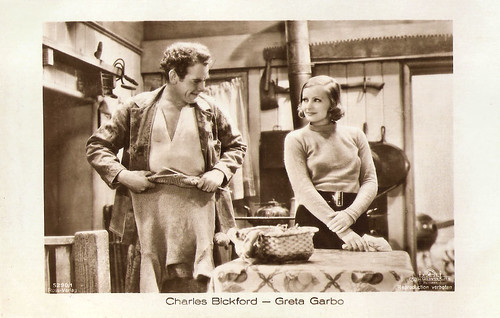
German postcard by Ross Verlag, no. 5290/1, 1930-1931. Photo: MGM. Greta Garbo and Charles Bickford in Anna Christie (Clarence Brown, 1930).
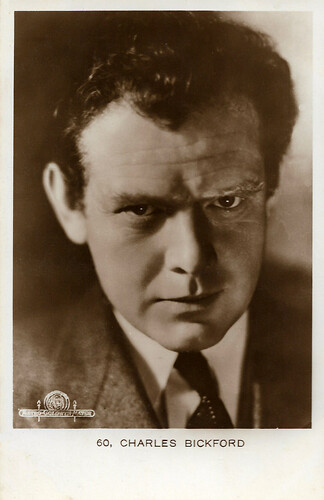
Belgian postcard by P.I.A. Belga Phot., Bruxelles, no. 60. Photo: Metro-Goldwyn-Mayer.
Mauled by a 400-pound lion
Charles Bickford soon became a star after playing Greta Garbo 's lover in Anna Christie (Clarence Brown, 1930) but he never developed into a leading man. Always of independent mind, exceptionally strong-willed and quick with his fists, Bickford would frequently argue and nearly come to blows with Mayer and any number of other MGM authority figures during the course of this contract with the studio.
During the production of DeMille's Dynamite, he punched out his director following a string of heated arguments primarily, but not exclusively, related to the interpretation of his character's role. Throughout his early career on both the stage and later films Bickford rejected numerous scripts and made no secret of his disdain for much of the material he was offered.
Not surprisingly, his association with MGM was short-lived, with Bickford asking for and quickly receiving a release from his contract. However, he soon found himself blacklisted at other studios, forcing him to take the highly unusual step (for that era) of becoming an independent actor for several years.
His career took another turn in 1935. While rehearsing a scene for Universal's East of Java (George Melford, 1935), he was mauled by a 400-pound lion on his neck and shoulders, very close to his jugular vein. it required nearly a year for him to recover from the injuries. While he recovered, he lost his contract with Fox as well as his leading-man status owing to extensive neck scarring suffered in the attack coupled with his advancing age.
It was not long, however, before he made a very successful transition to character roles, which he felt offered much greater diversity and allowed him to showcase his talent to better effect. Much preferring the character roles that now became his forte, Bickford appeared in many notable films, including The Farmer's Daughter (H.C. Potter, 1947) with Loretta Young, Johnny Belinda (Jean Negulesco, 1948) starring Jane Wyman, A Star is Born (George Cukor, 1954) starring Judy Garland and James Mason , and Not As a Stranger (Stanley Kramer, 1955), starring Olivia de Havilland , Robert Mitchum , and Frank Sinatra.
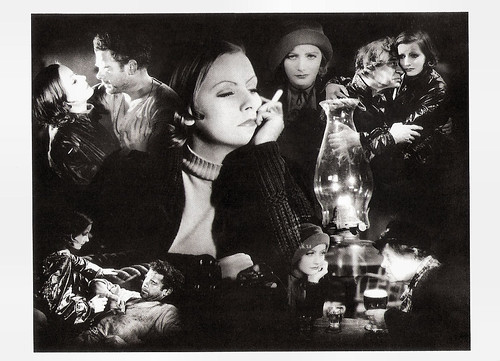
Swiss postcard by News Productions, Baulmes, no. 56490. Photo: Cinémathèque Suisse / Metro-Goldwyn-Mayer. Greta Garbo and Charles Bickford in Anna Christie (Clarence Brown, 1930). Design: Clarence Sinclair Bull, 1930.
Bulls Balls Bicycles & Actors
Finding great success playing an array of character roles in films and later in television, Charles Bickford quickly became highly sought after. His burly frame and craggy, intense features, coupled with a gruff, powerful voice lent themselves to a wide variety of roles. Most often he played lovable father figures, stern businessmen, heavies, ship captains or authority figures of some sort.
During the 1940s, he was nominated three times for the Academy Award for Best Supporting Actor, for The Song of Bernadette (Henry King, 1943) featuring Jennifer Jones, The Farmer's Daughter (H.C. Potter, 1947), and Johnny Belinda (Jean Negulesco, 1948).
In the 1950s, he served as host of the television series The Man Behind the Badge (1955). Bickford continued to act in generally prestigious projects right up to his death. He guest-starred on TV series like The Islanders (1960), The Barbara Stanwyck Show (1960), and The Eleventh Hour (1963).
In his final years, Bickford played rancher John Grainger, owner of the Shiloh Ranch, on the Western series The Virginian (1962-1968) with Doug McClure. Two of the actor's most memorable late-career big-screen roles were a wealthy and ruthless rancher in the Western The Big Country (William Wyler, 1958) starring Gregory Peck and Jean Simmons , and the forlorn father of an alcoholic (played by Lee Remick) in the drama Days of Wine and Roses (Blake Edwards, 1962).
In 1965, Bickford published his autobiography, 'Bulls Balls Bicycles & Actors'. In 1967, Charles Bickford died in Los Angeles of pneumonia and a blood infection at the age of 76. Jennifer Jones, who was a close friend of Bickford, attempted suicide on the day of his death, but it is not clear if Bickford's death had anything to do with the attempt. Since 1916, he had been married to Beatrice Loring. They had a son, Rex, and a daughter, Doris.
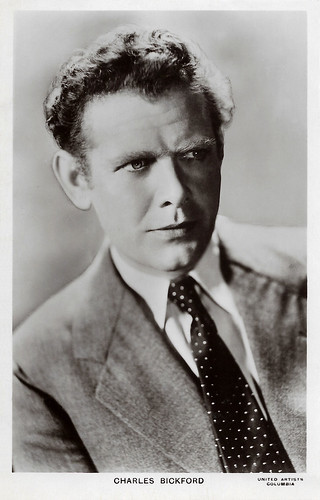
British postcard in the Picturegoer Series, London, no. 744. Photo: United Artists / Columbia.
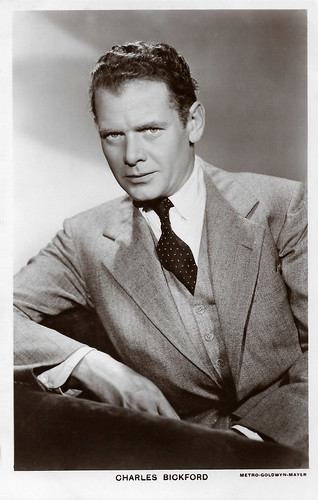
British postcard in the Picturegoer Series, London, no. 744a. Photo: Metro-Goldwyn-Mayer (MGM).
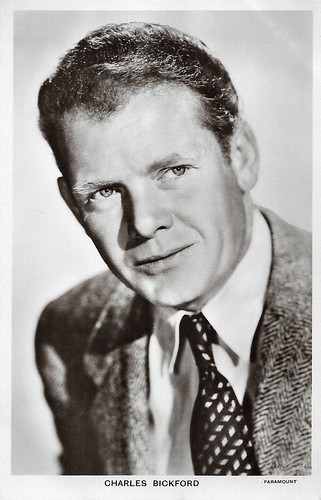
British postcard in the Picturegoer Series, London, no. 744b. Photo: Paramount.
Sources: (IMDb), Mordaunt Hall (New York Times), Wikipedia and .

German postcard by Ross Verlag, no. 5620/1, 1930-1931. Photo: Metro-Goldwyn-Mayer.

German postcard by Ross Verlag, no. 5515/1. Photo: MGM. Greta Garbo and Charles Bickford in Anna Christie (Clarence Brown, 1930).
Tried and acquitted of the attempted murder at age nine
Charles Ambrose Bickford was born in Cambridge, Massachusetts, during the first minute of 1891. His parents were Loretus and Mary Ellen Bickford. The fifth of seven children, he was an intelligent but very independent and unruly child. He had a particularly strong relationship with his maternal grandfather, a sea captain who was a powerful influence during his formative years.
At the age of nine, he was tried and acquitted of the attempted murder in the shooting of a trolley motorman who had callously driven over and killed his beloved dog. He attended Foster School and Everett High School. Always more interested in experiencing life than reading about it, Bickford was considered 'the wild rogue' of this family, causing his parents frequent consternation.
In his late teens, he drifted aimlessly around the United States for a time. Bickford had intended to attend the Massachusetts Institute of Technology to earn an engineering degree, but while wandering around the country, he became friends with the manager of a burlesque show, who convinced Bickford to take a role in the show. He debuted in Oakland, California, in 1911.
Before breaking into acting, he worked as a lumberjack and investment promoter and, for a short time, ran a pest extermination business. He also was a stoker and fireman in the United States Navy. His first entry into acting was on the stage, eventually including Broadway. This venue provided him with an occasional living and served as the principal training ground for developing his acting and vocal talents. Bickford enjoyed himself so much that he abandoned his plans to attend M.I.T.
He made his legitimate stage debut with the John Craig Stock Company at the Castle Square Theatre in Boston in 1912. During World War I, Bickford served as an engineer lieutenant in the United States Army. He eventually joined a road company and travelled throughout the United States for more than a decade, appearing in various productions.
In 1925, while working in a Broadway play called 'Outside Looking In', he and co-star James Cagney (in his first Broadway role) received rave reviews. The play was a smash hit, and Bickford was offered a role in the film Beau Geste (Herbert Brenon, 1926). Anxious not to give up his new found Broadway stardom, he turned it down, a decision he later regretted. Following his appearance in the critically praised but unsuccessful Maxwell Anderson-Harold Hickerson drama about the Sacco and Vanzetti case, 'Gods of the Lightning' (Bickford was the Sacco character), Bickford was contacted by filmmaker Cecil B. DeMille.
He was offered a contract with Metro-Goldwyn-Mayer to star in DeMille's first talking picture, Dynamite (Cecil B. DeMille, 1929), co-starring Conrad Nagel and Kay Johnson. Bickford played a coal miner Hagon Derk, who is sentenced to hang for murder. According to The New York Times reviewer Mordaunt Hall, Bickford gave "a splendid performance". Soon he began working with MGM studio head Louis B. Mayer on a number of projects.

German postcard by Ross Verlag, no. 5290/1, 1930-1931. Photo: MGM. Greta Garbo and Charles Bickford in Anna Christie (Clarence Brown, 1930).

Belgian postcard by P.I.A. Belga Phot., Bruxelles, no. 60. Photo: Metro-Goldwyn-Mayer.
Mauled by a 400-pound lion
Charles Bickford soon became a star after playing Greta Garbo 's lover in Anna Christie (Clarence Brown, 1930) but he never developed into a leading man. Always of independent mind, exceptionally strong-willed and quick with his fists, Bickford would frequently argue and nearly come to blows with Mayer and any number of other MGM authority figures during the course of this contract with the studio.
During the production of DeMille's Dynamite, he punched out his director following a string of heated arguments primarily, but not exclusively, related to the interpretation of his character's role. Throughout his early career on both the stage and later films Bickford rejected numerous scripts and made no secret of his disdain for much of the material he was offered.
Not surprisingly, his association with MGM was short-lived, with Bickford asking for and quickly receiving a release from his contract. However, he soon found himself blacklisted at other studios, forcing him to take the highly unusual step (for that era) of becoming an independent actor for several years.
His career took another turn in 1935. While rehearsing a scene for Universal's East of Java (George Melford, 1935), he was mauled by a 400-pound lion on his neck and shoulders, very close to his jugular vein. it required nearly a year for him to recover from the injuries. While he recovered, he lost his contract with Fox as well as his leading-man status owing to extensive neck scarring suffered in the attack coupled with his advancing age.
It was not long, however, before he made a very successful transition to character roles, which he felt offered much greater diversity and allowed him to showcase his talent to better effect. Much preferring the character roles that now became his forte, Bickford appeared in many notable films, including The Farmer's Daughter (H.C. Potter, 1947) with Loretta Young, Johnny Belinda (Jean Negulesco, 1948) starring Jane Wyman, A Star is Born (George Cukor, 1954) starring Judy Garland and James Mason , and Not As a Stranger (Stanley Kramer, 1955), starring Olivia de Havilland , Robert Mitchum , and Frank Sinatra.

Swiss postcard by News Productions, Baulmes, no. 56490. Photo: Cinémathèque Suisse / Metro-Goldwyn-Mayer. Greta Garbo and Charles Bickford in Anna Christie (Clarence Brown, 1930). Design: Clarence Sinclair Bull, 1930.
Bulls Balls Bicycles & Actors
Finding great success playing an array of character roles in films and later in television, Charles Bickford quickly became highly sought after. His burly frame and craggy, intense features, coupled with a gruff, powerful voice lent themselves to a wide variety of roles. Most often he played lovable father figures, stern businessmen, heavies, ship captains or authority figures of some sort.
During the 1940s, he was nominated three times for the Academy Award for Best Supporting Actor, for The Song of Bernadette (Henry King, 1943) featuring Jennifer Jones, The Farmer's Daughter (H.C. Potter, 1947), and Johnny Belinda (Jean Negulesco, 1948).
In the 1950s, he served as host of the television series The Man Behind the Badge (1955). Bickford continued to act in generally prestigious projects right up to his death. He guest-starred on TV series like The Islanders (1960), The Barbara Stanwyck Show (1960), and The Eleventh Hour (1963).
In his final years, Bickford played rancher John Grainger, owner of the Shiloh Ranch, on the Western series The Virginian (1962-1968) with Doug McClure. Two of the actor's most memorable late-career big-screen roles were a wealthy and ruthless rancher in the Western The Big Country (William Wyler, 1958) starring Gregory Peck and Jean Simmons , and the forlorn father of an alcoholic (played by Lee Remick) in the drama Days of Wine and Roses (Blake Edwards, 1962).
In 1965, Bickford published his autobiography, 'Bulls Balls Bicycles & Actors'. In 1967, Charles Bickford died in Los Angeles of pneumonia and a blood infection at the age of 76. Jennifer Jones, who was a close friend of Bickford, attempted suicide on the day of his death, but it is not clear if Bickford's death had anything to do with the attempt. Since 1916, he had been married to Beatrice Loring. They had a son, Rex, and a daughter, Doris.

British postcard in the Picturegoer Series, London, no. 744. Photo: United Artists / Columbia.

British postcard in the Picturegoer Series, London, no. 744a. Photo: Metro-Goldwyn-Mayer (MGM).

British postcard in the Picturegoer Series, London, no. 744b. Photo: Paramount.
Sources: (IMDb), Mordaunt Hall (New York Times), Wikipedia and .
Published on September 05, 2019 22:00
September 4, 2019
A passionate love doomed to fail
In the last post in our summer series on recent film books, EFSP has another Dutch curiosity. A novel about a legendary diva of the international opera houses who had vowed never to marry, who meets a heartbreaker with the angelic face that caused a furore on the stage. In 'De eerste vrouw' (The First Woman, 2016), Susan Smit depicts the tumultuous and love story between the American Geraldine Ferrar and the Dutchman Lou Tellegen, who starred together in three silent Hollywood films. Smit based her exciting novel on historical factual material.
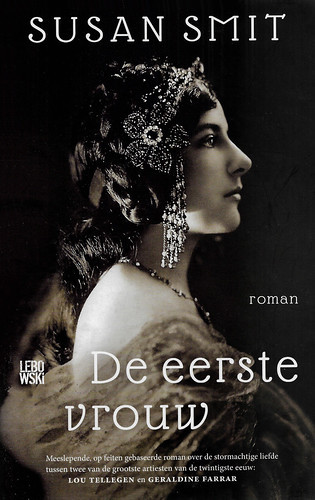
Book cover for Susan Smit, 'De eerste vrouw' (2016). Publisher: Lebowski, Amsterdam.
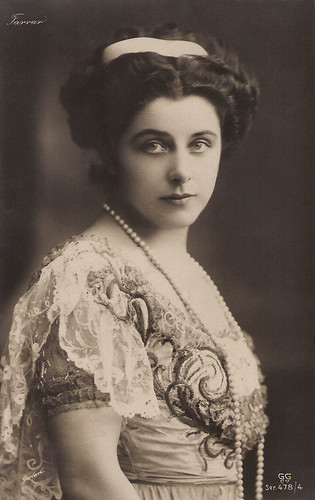
German postcard by G.G. & Co., no. 478/4. Photo: Gerlach.
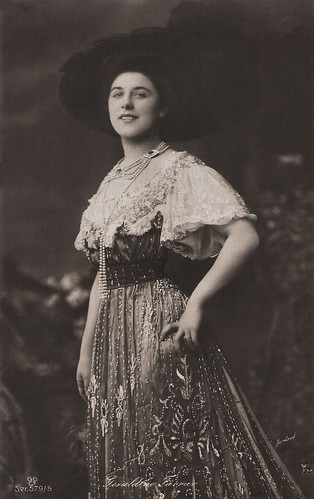
German postcard by G.G. & Co., no. 579/5. Photo: Gerlach.
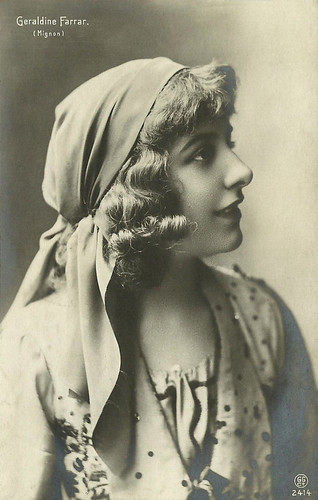
German postcard by G.G. & Co., no. 2414. Photo: Photo: Geraldine Farrar as Mignon in the opera 'Mignon'. Collection: Didier Hanson.
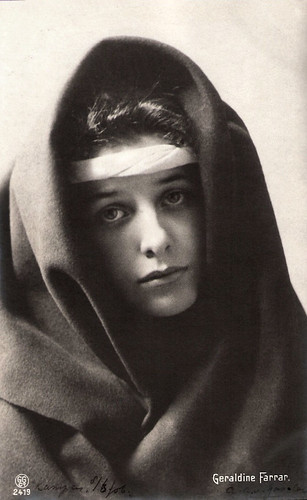
German postcard by G.G. & Co., no. 2419.
The toast of Berlin
Susan Smit unfolds in 'De eerste vrouw' the love story in two parts. First she tells about the years before Hollywood, in alternating chapters on the careers and lifes of 'Lou' and 'Geraldine'. At the end the two meet at an elegenat party in Holland House in New Tork. They immediately fall in love.
Alice Geraldine Farrar (1882-1967) had always been noted for her glamorous beauty, her acting talent, and the timbre of her voice. At 5 she already began studying music in Boston and by 14 was giving recitals. Barely 20, she was the toast of Berlin.
Farrar had created a sensation in 1901 at the Berlin Hofoper with her debut as Marguerite in Charles Gounod's 'Faust'. She remained with the company for three years, during which time she appeared in the title roles of Ambroise Thomas' 'Mignon' and Jules Massenet's 'Manon', as well as Juliette in Gounod's 'Roméo et Juliette'. Her admirers in Berlin included Crown Prince Wilhelm of Germany, with whom she is believed to have had a relationship beginning in 1903.
This Berlin period was interspersed with three seasons with the Monte Carlo Opera. Highlights were Pietro Mascagni's 'Amica' (1905), and Giuseppe Verdi's 'Rigoletto' (1906) in which she appeared with Enrico Caruso. In 1906, she also made her debut at the New York Metropolitan Opera in 'Roméo et Juliette'. The success placed her on a plateau with Caruso as a box-office magnet. The next year, she got raves for her performance as Cio-Cio-San in the Metropolitan premiere of Giacomo Puccini's 'Madama Butterfly' in 1907.
Geraldine Farrar had a seven-year love affair with the Italian conductor of the Met, Arturo Toscanini. It was rumored that she gave him an ultimatum that he must choose either her or his wife and children in Italy. It resulted in Toscanini's abrupt resignation as principal conductor of the Metropolitan Opera in 1915. Farrar was close friends with star tenor Enrico Caruso and there has been speculation that they too had a love affair, but no conclusive evidence of this has surfaced. At the Met, Farrar had a large following among young women, who were nicknamed ‘Gerry-flappers’. Farrar created the title roles in Puccini's 'Suor Angelica' (1918), Umberto Giordano's 'Madame Sans-Gêne' (1915), as well as the Goosegirl in Engelbert Humperdinck's 'Königskinder' (1910).
Her biographer Elizabeth Nash: “Unlike most of the famous bel canto singers of the past who sacrificed dramatic action to tonal perfection, she was more interested in the emotional than in the purely lyrical aspects of her roles.” Farrar remained a member of the company until her retirement in 1922, singing 29 roles there in 672 performances.
Geraldine Farrar also starred in more than a dozen silent films from 1915 to 1920, which were filmed between opera seasons. Farrar made her debut with the title role in Cecil B. De Mille's Carmen (1915), based on the novella 'Carmen' by Prosper Mérimée. For her role as the seductive gypsy girl she was extensively praised. DeMille directed her next in the silent romantic drama Temptation (Cecil B. DeMille, 1915), also with Theodore Roberts, and in the drama Maria Rosa (Cecil B. DeMille, 1916) with Wallace Reid.
Another notable screen role was as Joan of Arc in Joan the Woman (1917). This was Cecil B. DeMille's first historical drama. The screenplay is based on Friedrich Schiller's 1801 play 'Die Jungfrau von Orleans' (The Maid of Orleans).
She next played the daughter of an Aztec king in the silent romance The Woman God Forgot (Cecil B. DeMille, 1917). In the film she falls in love with a Spanish captain (Wallace Reid) whose army has come to convert the Aztecs to Christianity. Her last film for Paramount Pictures was the romance The Devil-Stone (Cecil B. DeMille, 1917), again with Wallace Reid. The film had sequences filmed in the Handschiegl Color Process, but only two of six reels are known to survive.
For Goldwyn Pictures, she appeared in such films as The Turn of the Wheel (Reginald Barker, 1918) with Herbert Rawlinson and Percy Marmont, the Western The Hell Cat (Reginald Barker, 1918), Shadows (Reginald Barker, 1918) and the melodrama The Stronger Vow (Reginald Barker, 1919), the latter three with Milton Sills. All four films are considered lost.
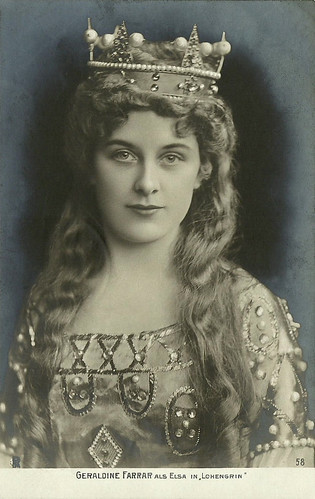
Vintage postcard, no. 58. Photo: Geraldine Farrar as Elsa in the opera 'Lohengrin'by Richard Wagner. Collection: Didier Hanson.
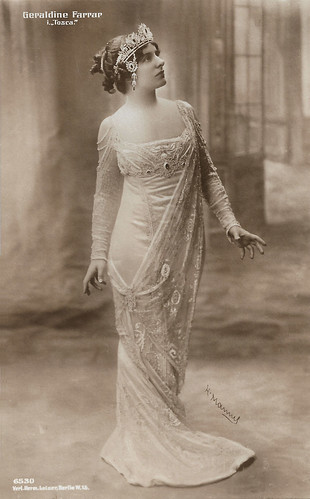
German postcard by Verlag Herm. Leiser, Berlin, no. 6530. Photo: H. Manuel. Geraldine Farrar as Tosca in the opera 'Tosca'.
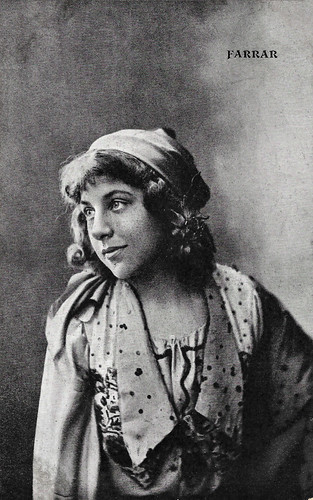
French postcard. Photo: Geraldine Farrar as Mignon in the opera 'Mignon'.
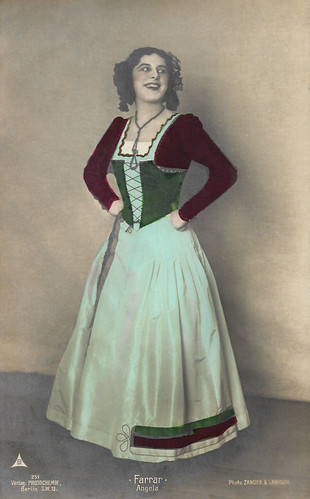
German postcard by Photochemie, Berlin, no. 251. Photo: Zander und Labisch. Geraldine Farrar as Angela in 'Le Domino Noir' (1905).
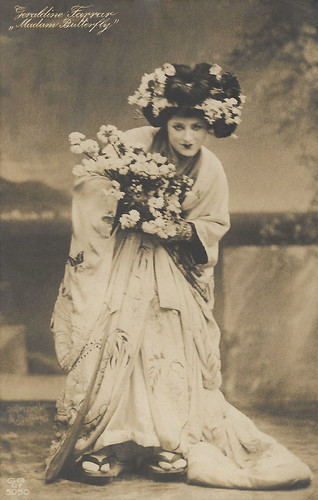
German postcard by GG Cie, no. 5050. Geraldine Farrar as Madam Butterfly in 'Madama Butterfly' (1907).
Romantically involved with the Divine Sarah
Lou Tellegen (1883-1934) was the illegitimate child of former army lieutenant Isidor Louis Bernard Edmon Tellegen and actress Anna Maria van Dommelen. In 1903, Lou made his stage debut in Rotterdam.
He moved to Brussels and later to Paris, where he worked as a model for such artists as Lacroix, Constantin Meunier and Auguste Rodin, and as a prize-boxer. He studied at the Conservatoire Nationale de Musique et de Déclamation, and worked for the Theatre de l'Odéon under André Antoine, the innovative founder of the Théâtre Libre.
Later he met dandy-actor Edouard de Max , who introduced him to Sarah Bernhardt . Eventually Lou co-starred in several roles with the Divine Sarah, and was also romantically involved with her. In 1910, he made his film debut as Armand Duval alongside Bernhardt in La dame aux camélias/Camille (Louis Mercanton, 1911), a French silent film based on the play by Alexandre Dumas, fils.
In 1910, Tellegen and Bernhardt travelled to the United States to appear on stage in 'Jeanne d’Arc' (Joan of Arc). Back in France, in 1912 they made their second film together, Les Amours de la reine Élisabeth/ Queen Elizabeth (Henri Desfontaines, Louis Mercanton, 1912). The film was an adaptation of a play by Émile Moreau about episodes of the life of Elizabeth I, Queen of England (1533-1603), and focused on her ill-fated love affair with Robert Devereux, Earl of Essex (Tellegen).
The film was an enormous success in the U.S., where it was distributed by Adolph Zukor. The following year, Bernhardt and Tellegen appeared again together in Adrienne Lecouvreur/An Actress's Romance (Henri Desfontaines, Louis Mercanton, 1913). The latter is considered a lost film. In the summer of 1913, Lou Tellegen went to London where he produced, directed and starred in the Oscar Wilde play 'The Picture of Dorian Gray'.
Invited back to the United States, Lou Tellegen worked in theatre and soon became a matinee idol. His leading role in the melodrama 'Maria Rosa' was a spectacular success. Samuel Goldwyn, Financial director of the Jesse L. Lasky Feature Play Company at the time, saw, Tellegen in 1915 in this play and offered him a contract for six films.
His American film début was The Explorer (George Melford, 1915), followed by The Unknown (George Melford, 1915), both with Dorothy Davenport as his co-star. The handsome Tellegen starred in numerous silent films opposite such stars as Sessue Hayakawa , in The Victoria Cross (Edward LeSaint, 1916), and Nell Shipman, in The Black Wolf (Frank Reicher, 1917).
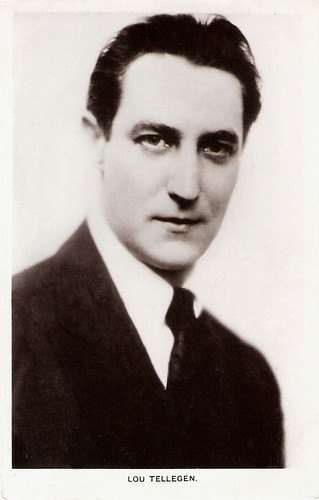
British postcard by Real Photograph in the Picturegoer series, London, no. 212.
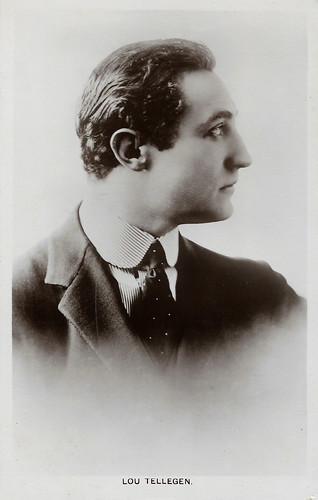
British postcard in the Picturegoer Series, no. 212a.
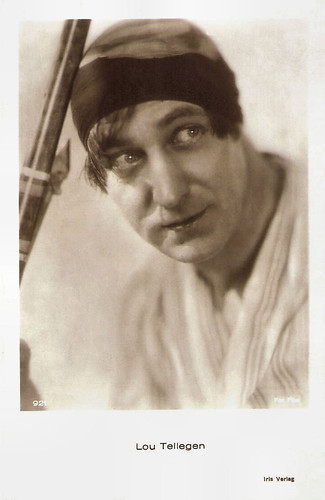
Austrian postcard by Iris Verlag, no. 921. Photo: Fox Film.
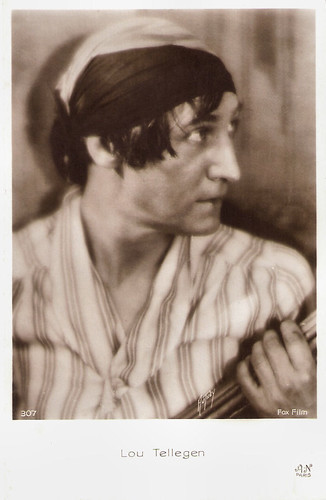
French postcard by A.N., Paris, no. 307. Photo: Max Munn Autrey / Fox Film.
A messy and very public divorce
In 1916, the opera diva turned film actress and the matinee idol married. They appeared in three films together: The World and Its Woman (Frank Lloyd, 1919), Flame of the Desert (Reginald Barker, 1919) and The Woman and the Puppet (Reginald Barker, 1920). Farrar's final film was the silent drama The Riddle: Woman (Edward José, 1920), in which her co-star was Montagu Love.
Lou Tellegen became an American citizen in 1918. He combined his work in the cinema with a successful stage career. Tellegen also worked as a producer and co-wrote two successful plays - 'Blind youth' (1917) with Willard Mack and 'The lust of gold' (1919) with Andor Garvay – which earned him a lot of money.
Tellegen was considered one of the best-looking actors of the silent screen, although our postcards don't confirm this. He was jealous about Farrar's successes and could not stand to be in her shadow. He started to drink and gamble, and numerous affairs followed. His marriage with Farrar became the source of considerable scandal. It ended in a messy and very public divorce in 1923.
Geraldine Farrar retired from opera in 1922 at the age of 40. Her final performance was as Leoncavallo's 'Zazà'. By this stage, her voice was in premature decline due to overwork. She quickly transitioned into concert recitals, and was signed (within several weeks of announcing her opera retirement) to an appearance at Hershey Park on Memorial Day 1922. She continued to make recordings and give recitals throughout the 1920s.
Lou Tellegen appeared in numerous silent films for Vitagraph and Fox Film, including The Redeeming Sin (J. Stuart Blackton, 1925) with Alla Nazimova , and Parisian Love (Louis J. Gasnier, 1925) with Clara Bow.
One of his memorable roles was as the corrupt Sheriff in John Ford's classic Western Three Bad Men (1926), wearing a white hat instead of the stereotypical bad guy black hat. He also directed a film starring Dolores del Rio , No Other Woman (Lou Tellegen, 1928), but it was not a success.
After his face was damaged in a hotel fire in 1929 and sound film had areived, Lou Tellegen ’s fame faded. Among his rare sound film appearances were a supporting part in the crime film Enemies of the Law (Lawrence C. Windom, 1931) with Mary Nolan , and a bit part in Caravane (Erik Charell, 1934) starring Charles Boyer .
Employment was not forthcoming and debt-ridden, he went bankrupt. He was diagnosed with cancer, though this information was kept from him, and he became despondent. In 1934, Tellegen locked himself in the bathroom of a mansion of a female admirer in Los Angeles. He shaved and powdered his face, and while standing in front of a full-length mirror, he committed harakiri by stabbing himself seven times with a pair of golden scissors (which had his name engraved on them).
When asked to comment on Tellegen's death, Geraldine Farrar replied candidly: "Why should that interest me?" The Tellegen interlude, the prima donna claimed long ago, left only "a surface scar." Smit imagines that Farrar must have been devastated. The handsome Dutchman had been the love of her life. She never remarried and had no children. In 1967, Farrar died in Ridgefield, Connecticut of heart disease, aged 85.
Susan Smit beautifully imagines Tellegen's and Farrar's boundless ambition, their doubts, fears and their passionate love that was doomed to fail. But at the same time the novel is the story of an exciting time in which Europe loses its innocence in a horrible war; the women's movement is slowly gaining ground, and a mass medium sees the light of day that changed the world forever: the cinema.
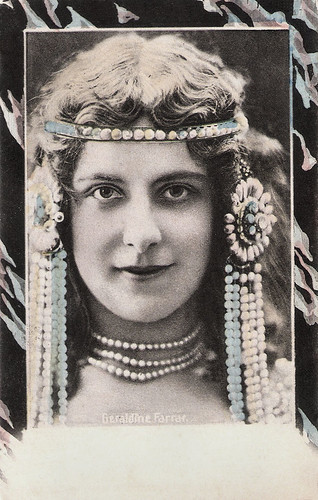
German postcard by K.V.i.B., Dess, no. 1016.
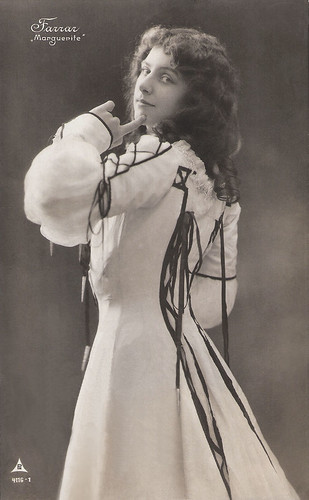
German postcard by PH, no. 4116/1. Geraldine Farrar as Marguerite in Charles Gounod's opera 'Faust'.
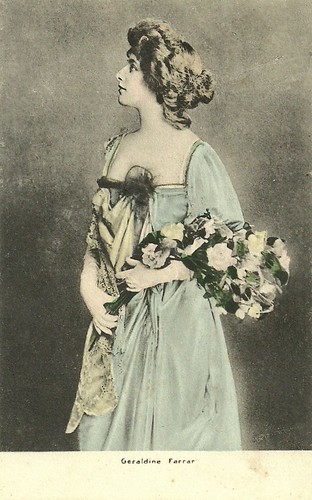
German postcard by K.V.i.B. 12. Dess., no. 4017.
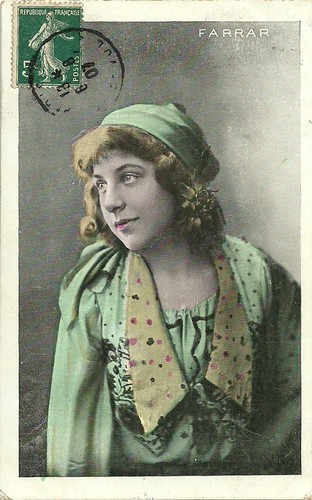
French postcard, sent by mail in 1907. Geraldine Farrar in the opera 'Mignon'.
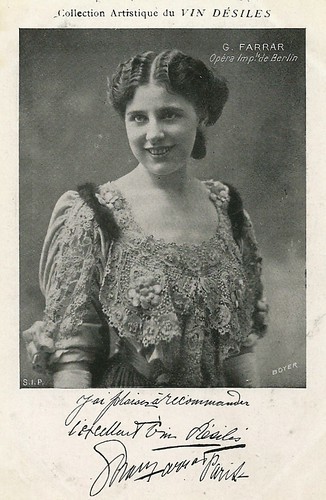
French postcard. Publicity for Vins Désiles. Photo SIP, Boyer. G. Farrar de l'Opéra Impéraile de Berlin. Caption: J'ai plaisir à recommander l'excellent Vin Désiles (I enjoy recommending the excellent V.D.).
Sources: Book, Bob Bertina (Lou Tellegen. Een Hollander in Hollywood, VN Bijlage 1985 - Dutch), A.J.C.M. Gabriëls (Institute of Netherlands History), Andrea Suhm-Binder (Cantabile subito), Bob Hufford (Find A Grave), Wikipedia and .

Book cover for Susan Smit, 'De eerste vrouw' (2016). Publisher: Lebowski, Amsterdam.

German postcard by G.G. & Co., no. 478/4. Photo: Gerlach.

German postcard by G.G. & Co., no. 579/5. Photo: Gerlach.

German postcard by G.G. & Co., no. 2414. Photo: Photo: Geraldine Farrar as Mignon in the opera 'Mignon'. Collection: Didier Hanson.

German postcard by G.G. & Co., no. 2419.
The toast of Berlin
Susan Smit unfolds in 'De eerste vrouw' the love story in two parts. First she tells about the years before Hollywood, in alternating chapters on the careers and lifes of 'Lou' and 'Geraldine'. At the end the two meet at an elegenat party in Holland House in New Tork. They immediately fall in love.
Alice Geraldine Farrar (1882-1967) had always been noted for her glamorous beauty, her acting talent, and the timbre of her voice. At 5 she already began studying music in Boston and by 14 was giving recitals. Barely 20, she was the toast of Berlin.
Farrar had created a sensation in 1901 at the Berlin Hofoper with her debut as Marguerite in Charles Gounod's 'Faust'. She remained with the company for three years, during which time she appeared in the title roles of Ambroise Thomas' 'Mignon' and Jules Massenet's 'Manon', as well as Juliette in Gounod's 'Roméo et Juliette'. Her admirers in Berlin included Crown Prince Wilhelm of Germany, with whom she is believed to have had a relationship beginning in 1903.
This Berlin period was interspersed with three seasons with the Monte Carlo Opera. Highlights were Pietro Mascagni's 'Amica' (1905), and Giuseppe Verdi's 'Rigoletto' (1906) in which she appeared with Enrico Caruso. In 1906, she also made her debut at the New York Metropolitan Opera in 'Roméo et Juliette'. The success placed her on a plateau with Caruso as a box-office magnet. The next year, she got raves for her performance as Cio-Cio-San in the Metropolitan premiere of Giacomo Puccini's 'Madama Butterfly' in 1907.
Geraldine Farrar had a seven-year love affair with the Italian conductor of the Met, Arturo Toscanini. It was rumored that she gave him an ultimatum that he must choose either her or his wife and children in Italy. It resulted in Toscanini's abrupt resignation as principal conductor of the Metropolitan Opera in 1915. Farrar was close friends with star tenor Enrico Caruso and there has been speculation that they too had a love affair, but no conclusive evidence of this has surfaced. At the Met, Farrar had a large following among young women, who were nicknamed ‘Gerry-flappers’. Farrar created the title roles in Puccini's 'Suor Angelica' (1918), Umberto Giordano's 'Madame Sans-Gêne' (1915), as well as the Goosegirl in Engelbert Humperdinck's 'Königskinder' (1910).
Her biographer Elizabeth Nash: “Unlike most of the famous bel canto singers of the past who sacrificed dramatic action to tonal perfection, she was more interested in the emotional than in the purely lyrical aspects of her roles.” Farrar remained a member of the company until her retirement in 1922, singing 29 roles there in 672 performances.
Geraldine Farrar also starred in more than a dozen silent films from 1915 to 1920, which were filmed between opera seasons. Farrar made her debut with the title role in Cecil B. De Mille's Carmen (1915), based on the novella 'Carmen' by Prosper Mérimée. For her role as the seductive gypsy girl she was extensively praised. DeMille directed her next in the silent romantic drama Temptation (Cecil B. DeMille, 1915), also with Theodore Roberts, and in the drama Maria Rosa (Cecil B. DeMille, 1916) with Wallace Reid.
Another notable screen role was as Joan of Arc in Joan the Woman (1917). This was Cecil B. DeMille's first historical drama. The screenplay is based on Friedrich Schiller's 1801 play 'Die Jungfrau von Orleans' (The Maid of Orleans).
She next played the daughter of an Aztec king in the silent romance The Woman God Forgot (Cecil B. DeMille, 1917). In the film she falls in love with a Spanish captain (Wallace Reid) whose army has come to convert the Aztecs to Christianity. Her last film for Paramount Pictures was the romance The Devil-Stone (Cecil B. DeMille, 1917), again with Wallace Reid. The film had sequences filmed in the Handschiegl Color Process, but only two of six reels are known to survive.
For Goldwyn Pictures, she appeared in such films as The Turn of the Wheel (Reginald Barker, 1918) with Herbert Rawlinson and Percy Marmont, the Western The Hell Cat (Reginald Barker, 1918), Shadows (Reginald Barker, 1918) and the melodrama The Stronger Vow (Reginald Barker, 1919), the latter three with Milton Sills. All four films are considered lost.

Vintage postcard, no. 58. Photo: Geraldine Farrar as Elsa in the opera 'Lohengrin'by Richard Wagner. Collection: Didier Hanson.

German postcard by Verlag Herm. Leiser, Berlin, no. 6530. Photo: H. Manuel. Geraldine Farrar as Tosca in the opera 'Tosca'.

French postcard. Photo: Geraldine Farrar as Mignon in the opera 'Mignon'.

German postcard by Photochemie, Berlin, no. 251. Photo: Zander und Labisch. Geraldine Farrar as Angela in 'Le Domino Noir' (1905).

German postcard by GG Cie, no. 5050. Geraldine Farrar as Madam Butterfly in 'Madama Butterfly' (1907).
Romantically involved with the Divine Sarah
Lou Tellegen (1883-1934) was the illegitimate child of former army lieutenant Isidor Louis Bernard Edmon Tellegen and actress Anna Maria van Dommelen. In 1903, Lou made his stage debut in Rotterdam.
He moved to Brussels and later to Paris, where he worked as a model for such artists as Lacroix, Constantin Meunier and Auguste Rodin, and as a prize-boxer. He studied at the Conservatoire Nationale de Musique et de Déclamation, and worked for the Theatre de l'Odéon under André Antoine, the innovative founder of the Théâtre Libre.
Later he met dandy-actor Edouard de Max , who introduced him to Sarah Bernhardt . Eventually Lou co-starred in several roles with the Divine Sarah, and was also romantically involved with her. In 1910, he made his film debut as Armand Duval alongside Bernhardt in La dame aux camélias/Camille (Louis Mercanton, 1911), a French silent film based on the play by Alexandre Dumas, fils.
In 1910, Tellegen and Bernhardt travelled to the United States to appear on stage in 'Jeanne d’Arc' (Joan of Arc). Back in France, in 1912 they made their second film together, Les Amours de la reine Élisabeth/ Queen Elizabeth (Henri Desfontaines, Louis Mercanton, 1912). The film was an adaptation of a play by Émile Moreau about episodes of the life of Elizabeth I, Queen of England (1533-1603), and focused on her ill-fated love affair with Robert Devereux, Earl of Essex (Tellegen).
The film was an enormous success in the U.S., where it was distributed by Adolph Zukor. The following year, Bernhardt and Tellegen appeared again together in Adrienne Lecouvreur/An Actress's Romance (Henri Desfontaines, Louis Mercanton, 1913). The latter is considered a lost film. In the summer of 1913, Lou Tellegen went to London where he produced, directed and starred in the Oscar Wilde play 'The Picture of Dorian Gray'.
Invited back to the United States, Lou Tellegen worked in theatre and soon became a matinee idol. His leading role in the melodrama 'Maria Rosa' was a spectacular success. Samuel Goldwyn, Financial director of the Jesse L. Lasky Feature Play Company at the time, saw, Tellegen in 1915 in this play and offered him a contract for six films.
His American film début was The Explorer (George Melford, 1915), followed by The Unknown (George Melford, 1915), both with Dorothy Davenport as his co-star. The handsome Tellegen starred in numerous silent films opposite such stars as Sessue Hayakawa , in The Victoria Cross (Edward LeSaint, 1916), and Nell Shipman, in The Black Wolf (Frank Reicher, 1917).

British postcard by Real Photograph in the Picturegoer series, London, no. 212.

British postcard in the Picturegoer Series, no. 212a.

Austrian postcard by Iris Verlag, no. 921. Photo: Fox Film.

French postcard by A.N., Paris, no. 307. Photo: Max Munn Autrey / Fox Film.
A messy and very public divorce
In 1916, the opera diva turned film actress and the matinee idol married. They appeared in three films together: The World and Its Woman (Frank Lloyd, 1919), Flame of the Desert (Reginald Barker, 1919) and The Woman and the Puppet (Reginald Barker, 1920). Farrar's final film was the silent drama The Riddle: Woman (Edward José, 1920), in which her co-star was Montagu Love.
Lou Tellegen became an American citizen in 1918. He combined his work in the cinema with a successful stage career. Tellegen also worked as a producer and co-wrote two successful plays - 'Blind youth' (1917) with Willard Mack and 'The lust of gold' (1919) with Andor Garvay – which earned him a lot of money.
Tellegen was considered one of the best-looking actors of the silent screen, although our postcards don't confirm this. He was jealous about Farrar's successes and could not stand to be in her shadow. He started to drink and gamble, and numerous affairs followed. His marriage with Farrar became the source of considerable scandal. It ended in a messy and very public divorce in 1923.
Geraldine Farrar retired from opera in 1922 at the age of 40. Her final performance was as Leoncavallo's 'Zazà'. By this stage, her voice was in premature decline due to overwork. She quickly transitioned into concert recitals, and was signed (within several weeks of announcing her opera retirement) to an appearance at Hershey Park on Memorial Day 1922. She continued to make recordings and give recitals throughout the 1920s.
Lou Tellegen appeared in numerous silent films for Vitagraph and Fox Film, including The Redeeming Sin (J. Stuart Blackton, 1925) with Alla Nazimova , and Parisian Love (Louis J. Gasnier, 1925) with Clara Bow.
One of his memorable roles was as the corrupt Sheriff in John Ford's classic Western Three Bad Men (1926), wearing a white hat instead of the stereotypical bad guy black hat. He also directed a film starring Dolores del Rio , No Other Woman (Lou Tellegen, 1928), but it was not a success.
After his face was damaged in a hotel fire in 1929 and sound film had areived, Lou Tellegen ’s fame faded. Among his rare sound film appearances were a supporting part in the crime film Enemies of the Law (Lawrence C. Windom, 1931) with Mary Nolan , and a bit part in Caravane (Erik Charell, 1934) starring Charles Boyer .
Employment was not forthcoming and debt-ridden, he went bankrupt. He was diagnosed with cancer, though this information was kept from him, and he became despondent. In 1934, Tellegen locked himself in the bathroom of a mansion of a female admirer in Los Angeles. He shaved and powdered his face, and while standing in front of a full-length mirror, he committed harakiri by stabbing himself seven times with a pair of golden scissors (which had his name engraved on them).
When asked to comment on Tellegen's death, Geraldine Farrar replied candidly: "Why should that interest me?" The Tellegen interlude, the prima donna claimed long ago, left only "a surface scar." Smit imagines that Farrar must have been devastated. The handsome Dutchman had been the love of her life. She never remarried and had no children. In 1967, Farrar died in Ridgefield, Connecticut of heart disease, aged 85.
Susan Smit beautifully imagines Tellegen's and Farrar's boundless ambition, their doubts, fears and their passionate love that was doomed to fail. But at the same time the novel is the story of an exciting time in which Europe loses its innocence in a horrible war; the women's movement is slowly gaining ground, and a mass medium sees the light of day that changed the world forever: the cinema.

German postcard by K.V.i.B., Dess, no. 1016.

German postcard by PH, no. 4116/1. Geraldine Farrar as Marguerite in Charles Gounod's opera 'Faust'.

German postcard by K.V.i.B. 12. Dess., no. 4017.

French postcard, sent by mail in 1907. Geraldine Farrar in the opera 'Mignon'.

French postcard. Publicity for Vins Désiles. Photo SIP, Boyer. G. Farrar de l'Opéra Impéraile de Berlin. Caption: J'ai plaisir à recommander l'excellent Vin Désiles (I enjoy recommending the excellent V.D.).
Sources: Book, Bob Bertina (Lou Tellegen. Een Hollander in Hollywood, VN Bijlage 1985 - Dutch), A.J.C.M. Gabriëls (Institute of Netherlands History), Andrea Suhm-Binder (Cantabile subito), Bob Hufford (Find A Grave), Wikipedia and .
Published on September 04, 2019 22:00
Paul van Yperen's Blog
- Paul van Yperen's profile
- 13 followers
Paul van Yperen isn't a Goodreads Author
(yet),
but they
do have a blog,
so here are some recent posts imported from
their feed.



